HOW WE FUNDRAISE Icons,
INSIDE:

• Nurturing a Culture of Volunteerism
• Quiet Quitting in the NFP Sector
• Donor Behaviour
Insights 2023
January/February 2023 | Vol. 4 | No. 18
PM40050803
COURTESY BELL CANADA LET’S TALK DAY
Ideas, Imagination
We’ll Help You Keep It Clean
Dealing with bad data is a task no nonpro t organization needs on their checklist. Inaccurate, outdated, and duplicate records can build up in your database, affecting your outreach efforts, response rates and campaign results. As the Address Experts, Melissa helps our customers meet their fundraising goals with the best Address Veri cation, Identity Veri cation and Data Enrichment solutions available. We validated 30 billion records last year alone, which is why thousands of businesses worldwide have trusted us with their data quality needs for 37+ years.
BAD DATA BUILDUP
Undeliverable Mail
Missed Opportunities
Decreased Donor Insight
DATA CLEANLINESS
Real-time Address Veri cation
Change of Address/NCOA Processing
Demographics & Lifestyle Data

Melissa.com 800.MELISSA (635-4772) Trust the Address Experts to deliver high-quality address veri cation, identity resolution, and data hygiene solutions.
us for a Free Proof of Concept and ask about our 120-day ROI Guarantee.
Contact
The World Around Us
The Avian Virus: An Enemy of Sea Lions
A scientific analysis is thought to link migratory birds from the U.S. as responsible for transmitting the bird flu to hundreds of sea lions which have died of bird flu in Peru in recent weeks. Authorities are urging people to stay away from the beaches.
More than 55,000 dead birds, including pelicans and penguins, have been discovered across eight protected coastal areas, the Sernanp natural area protection agency said.
Wildlife rangers in the region found that the bird flu which killed them had also claimed the lives of 585 sea lions in seven different protected marine areas. Lab tests confirmed the presence of the virus in these animals, prompting authorities to announce a “biological vigilance protocol”.

Peru’s National Forest and Wildlife Service (SERFOR) has urged people and their pets to avoid contact with sea lions and seabirds on the beach.
In November, Peru declared a 180-day health alert after finding three cases of highly contagious bird flu in pelicans. Then, in December, 37,000 birds on a chicken farm were culled after a previous outbreak affected wildlife. Killing the birds is a part of standard protocol to prevent the spread of avian influenza.
Scientists at the Paracas National Reserve are deploying a monitoring and surveillance protocol for
/ AFP
cases of bird flu.SERNANP
It is rare that the H5N1 bird flu virus jumps over to mammals and even rarer that humans catch it. But it has been found in foxes and otters in Britain, a cat in France and grizzly bears in Montana, US.
All of the mammals that caught the virus are thought to have eaten infected birds.
Since late 2021, Europe has been gripped by the worst-ever outbreak of the virus. North and South America have seen severe outbreaks too.
World Health Organisation director general Tedros Adhanom Ghebreyesus warned that these cases of H5N1 in mammals must be “closely monitored”.
He said that the risk to humans was currently low but “we cannot assume that will remain the case and we must prepare for any change in the status quo.”
Ghebreyesus cautioned people against touching sick or dead animals and encouraged those who find them to report them to local authorities.

3 January/February 2023 FOUNDATION Magazine foundationmag.ca THE LEAD IN
ISTOCK/ METAMORWORKS
Scientists in Peru collect data about virus-stricken seals.
CONTENTS
January/February 2023 | Vol. 4 | No. 18
www.foundationmag.ca
Twitter: @foundationmaga1
PRESIDENT / EDITOR-IN-CHIEF
Steve Lloyd - steve.lloyd@lloydmedia.ca
SENIOR ADVERTISING MANAGER
Taylor Carmichael - taylor@lloydmedia.ca
DESIGN / PRODUCTION
Jennifer O’Neill - jennifer@dmn.ca
PHOTOGRAPHER
Gary Tannyan
CONTRIBUTING WRITERS
Heather Baker
Malcolm Burrows

Mary Cahalane
Matt Charters
LLOYDMEDIA INC.
HEAD OFFICE / SUBSCRIPTIONS / PRODUCTION:
302-137 Main Street North
Markham ON L3P 1Y2
Phone: 905.201.6600
Fax: 905.201.6601 Toll-free: 800.668.1838
EDITORIAL CONTACT:
Foundation Magazine is published bimonthly by Lloydmedia Inc.
Foundation Magazine may be obtained through paid subscription. Rates:
Canada 1 year (6 issues $48)
2 years (12 issues $70)
U.S. 1 year (6 issues $60)
2 years (12 issues $100)
Foundation Magazine is an independently-produced publication not affiliated in any way with any association or organized group nor with any publication produced either in Canada or the United States. Unsolicited manuscripts are welcome. However unused manuscripts will not be returned unless accompanied by sufficient postage. Occasionally Foundation Magazine provides its subscriber mailing list to other companies whose product or service may be of value to readers. If you do not want to receive information this way simply send your subscriber mailing label with this notice to: Lloydmedia Inc. 302-137 Main Street North Markham ON L3P 1Y2 Canada.
POSTMASTER:
Please send all address changes and return all undeliverable copies to: Lloydmedia Inc.
302-137 Main Street North Markham ON L3P 1Y2 Canada
Canada Post Canadian Publications
Mail Sales Product Agreement No. 40050803
4 FOUNDATION Magazine January/February 2023 foundationmag.ca
Sarah Chamberlin
Jason Egbuna
Mark Halpern
Maryann Kerr
Kathleen A. Provost
Louise Sparks
Jody Spiegel
Sevetri Wilson
6 SEEN, HEARD & NOTED COLUMNIST 10 Estate Donations That Don’t Get Made Wealth Management - Malcolm Burrows 12 Welcoming a New Era with a Human Touch Leadership - Kathleen Provost 14 Raised to be Nice Thinking Out Loud - Maryann Kerr 16 No One Left Behind Marketing & fundraising - Sarah Chamberlin 18 The Philanthropic Powers of Life Insurance The Accidental Philanthropist - Mark Halpern 3 THE LEAD IN COURTESY BELL CANADA LET’S TALK DAY ON THE COVER Signal
St
lit
blue
Bell Let’s Talk Day
Hill in
John’s
up
on
2023








5 January/February 2023 FOUNDATION Magazine foundationmag.ca CONTENTS Next Issue… In the March/April Issue of Foundation Magazine, Challenges in Corporate Philanthropic Partnerships VOLUNTEERISM 22 Nurturing a Culture of Volunteerism RECOGNITION 46 Five Lives: What We Do HISTORIC PLAQUES 45 Isabella Binney Cogswell, Halifax, Nova Scotia TECHNOLOGY 28 How Funders can Help Grassroots and Indigenous-led Nonprofits Thrive Using Technology 43 CharityCAN’s 2022 in Review and ChatGPT HISTORY 32 The Azrieli Foundation Launches Education Disrupted FUNDRAISING 34 Fundraising in Canada: Donor Behaviour Insights 2023 40 Why the AI Robots Are Not Going to Take Your Job INSIGHT 44 In Conversation with Jennifer Johnstone, Chair, AFP Canada STAFFING 26 Examining Quiet Quitting in the NFP Sector 26 28 32 34 40 43 44 VECTEEZY.COM
ISTOCK/ MELITAS ISTOCK/ KERKEZ ISTOCK/
TASHKA
ISTOCK/ PAUL BRADBURY ISTOCK/ ANDREYPOPOV
Twice as many families will have direct access to fresh food in 2023 thanks to Lufa Farms. The launch of their registered charity in order to grow their Direct Giving Program is a vital step toward improving access to fresh food for Quebec families in need is accompanied by a new long-term partnership with the Fondation Lucie et André Chagnon through their mission-oriented investment of $7 million made in the form of a loan. The company will be supporting twice as many families without any administrative costs thanks to their automated online platform. The Lufa Farms Foundation is fully independent with dedicated governance, making it possible to collect external donations and meet the basic needs of families in vulnerable situations. The investment made by the Chagnon Foundation will contribute to the continuation of The Direct Giving Program.
“This new partnership with the Lufa Farms Foundation
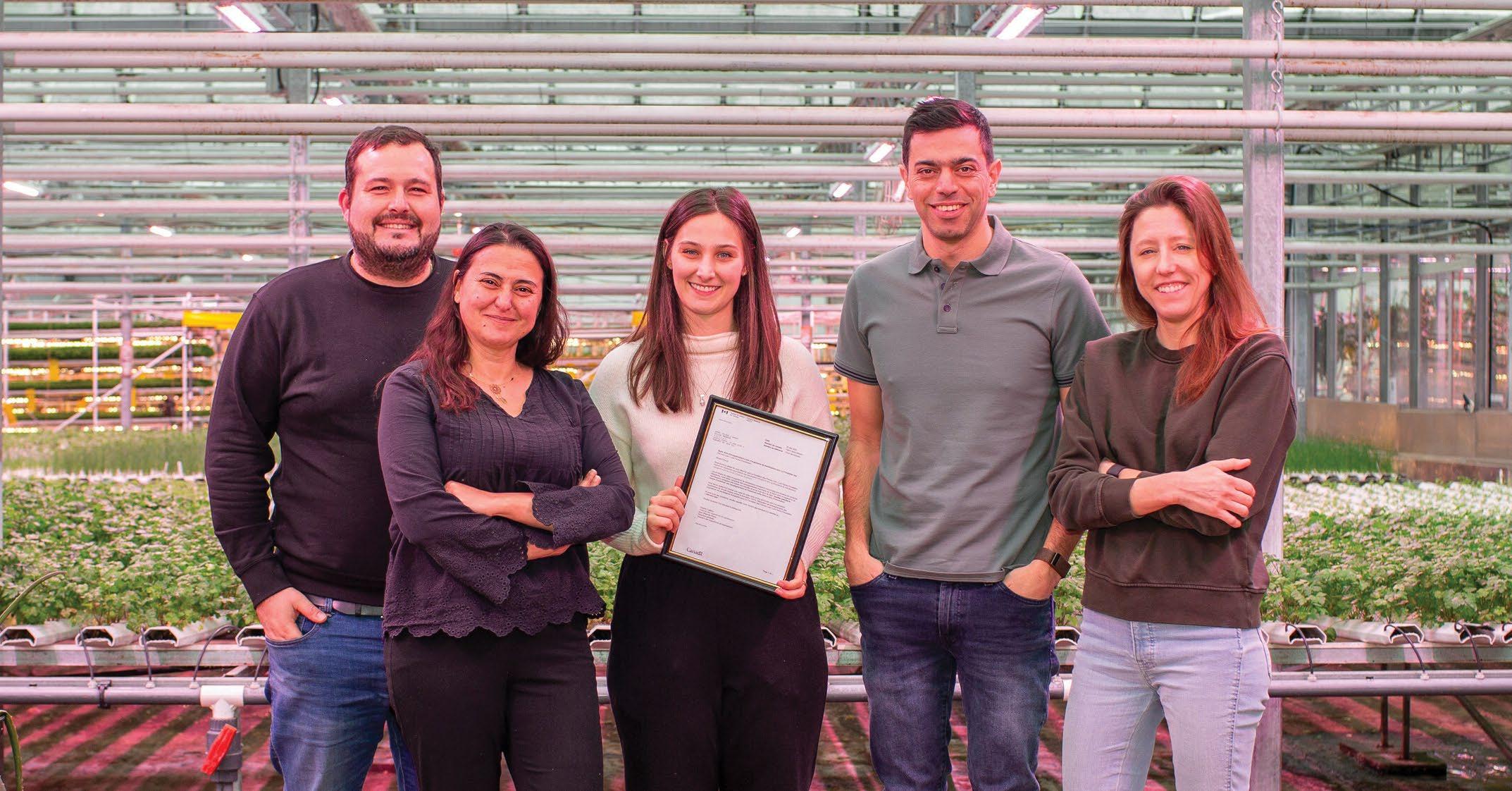
and the Lucie and André Chagnon Foundation allows us to build a whole new form of effective, direct, and transparent philanthropy in order to improve food security in Quebec,” said Mohamed Hage, Co-CEO of Lufa Farms.
This spring, the Foundation will be doubling their beneficiary from 125 to 250 families thanks to the generosity of their customers and the support of their new partner, the Lucie and André Chagnon Foundation
The Foundation is now looking for new partner organizations who are also fighting food insecurity to support even more individuals in need.
How it works: Beneficiaries receive $25 per week per family member plus a 50 percent discount on fruits and vegetables to shop for online groceries delivered to their home (just like any other Lufa Farms customer). Number of beneficiary families: 120 families (550 people/ individuals in all).
Number of partner organizations affiliated to the program: 7.
Number of individual donors in 2022: 9,859.
Amount of donations received in 2022: $470,000.
Amount granted by Lufa Farms: $93,000.
Administrative and overhead costs for program management: $0.
A new Canadian nonprofit coalition is targeting employee ownership as an urgent multi-$billion opportunity for workers. The Canadian Employee Ownership Coalition (CEOC) cites Employee Ownership Trusts (EOTs) as a tool for creating a stronger, more resilient economy and building middle-class wealth.
According to a recent report from the Canadian Federation of Independent Business (CFIB) 76 percent of business owners say they’re planning to exit their business over the next decade. CEOC believes Ottawa must act
now to keep its commitment to introduce EOTs into the Income Tax Act, along with new incentives for retiring business owners to sell their companies to their employees.
The CEOC is a diverse, nonpartisan network of Canadians from the business, banking, nonprofit, academic and charitable sectors who believe that with the right policies in place, employee-ownership will scale quickly in Canada, creating billions of dollars of wealth for everyday workers across this country. A recent report con firmed this potential, projecting as many as 750 companies could sell to EOTs within 8 years, creating as much as $9.6B in wealth for as many as 115,000 Canadian workers.
“Business owners across the country, including me, have a strong desire to eventually sell our businesses to our hard-working employees,” says Coalition Steering Committee member Tim Masson, CEO of Toronto-based Raise Recruiting.
6 FOUNDATION Magazine January/February 2023 foundationmag.ca SEEN, HEARD & NOTED
• • • • • • • • • • • • • • • • • • • • • • • •
Ottawa pledged to study the barriers to employee ownership in its 2021 budget, and committed last year to introduce a new, dedicated Employee Ownership Trust to give retiring business owners more incentive to sell to their employees. The federal government has not yet released draft proposals or legislation.
The Coalition is calling on the federal government to use Budget 2023 to introduce a dedicated Employee Ownership Trust, remove tax barriers to employee ownership by adopting the U.K.’s approach of a Capital Gains Tax exemption, and introduce clear, simple rules that protect taxpayers and employees. EOTs are proven public policy. In the U.S., where these policies have been in place since the 1970s, 14 million American workers are already sharing in $1.7 trillion of wealth. Since the U.K. introduced these policies in 2014 it has witnessed rapid adoption, with 700 companies with more than 55,000 employees becoming employee-owned between 2014-2021.This past year has been record shattering in the U.K., with nearly 500 Employee Ownership Trusts being established in the last 12 months to the end of September.
Christine Cooper, EVP & Head of Commercial Banking at Bank of Montreal and a member of the Coalition’s Steering Committee noted, “In the U.S., employeeowners earn higher salaries and build more wealth than their peers, and this is especially true for women and people of colour. We should be encouraging this at every step and making it a viable alternative for the growing number of retiring Canadian business owners.”
The CEOC includes one of Canada’s largest banks, small and
large business owners, some of the country’s leading tax, accounting and public policy professionals, in addition to nonprofit and charitable sector leaders from across the country.
The CEOC believes adoption of Employee Ownership Trusts, with appropriate incentives, will scale quickly, resulting in stronger companies that stay in their local communities for the long term, and significant wealth-building for Canadian workers.
The CEOC is calling on the government to create an Employee Ownership Trust under the Income Tax Act in Budget 2023, among many other actions. EOTs are a way for business owners to sell all or part of their businesses to their employees.
They are most commonly used for the succession of privately-held companies with between 20 and 500 employees. This is a significant market in Canada, with over 140,000 companies employing almost five million Canadians, according to Statistics Canada.
The CEOC will continue to add to its membership over the coming months.
Enhanced iWave for Salesforce Integration Brings Automated Wealth Scoring to Nonprofits. iWave, the industry’s top-rated fundraising intelligence platform, today announced that it has released new enhancements to the iWave for Salesforce integration on the Salesforce AppExchange.
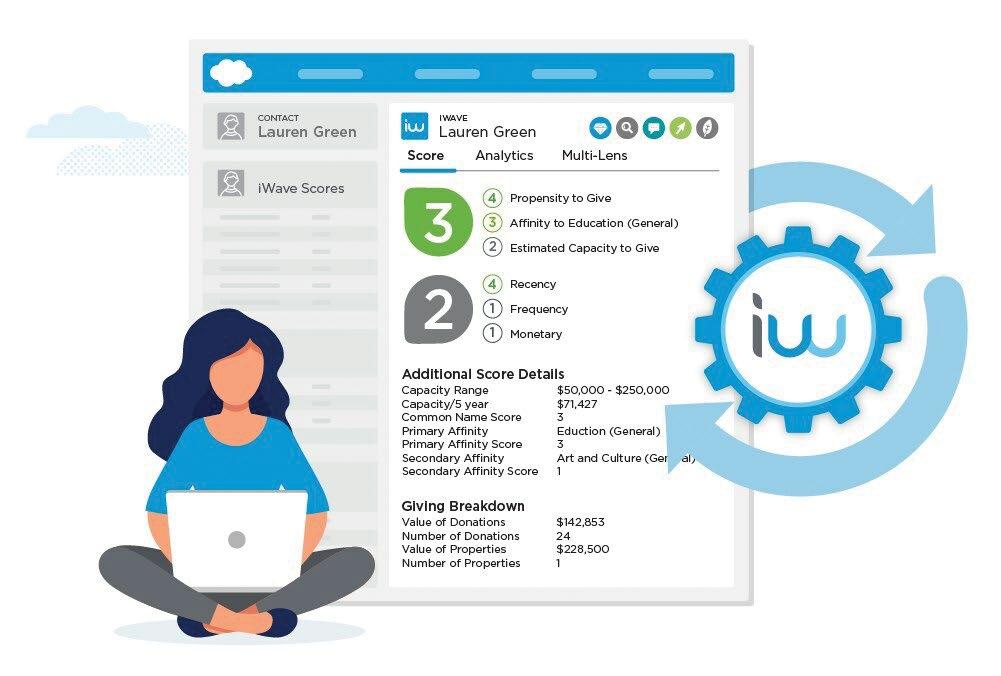
The latest version includes Automated Scoring, a new feature that enables fundraising professionals to understand the giving potential of new constituents, as soon as they are added to Salesforce. Additionally, nonprofits can optimize their cultivation efforts by using
customizable scoring triggers to automatically receive the latest wealth and philanthropic intelligence in Salesforce.
By integrating iWave and Salesforce, fundraising professionals can enrich their internal Salesforce data with iWave’s fundraising intelligence to identify ideal donors, find new prospects, personalize outreach, and ultimately raise more donations using a frictionless workflow. Automated Scoring further enhances the ability to prioritize donors who have additional giving potential, and provides new cultivation and solicitation opportunities.
Numerous studies have shown that timing is essential to maximizing fundraising outcome. For example, donors are much more likely to give a second gift within the first three months. With Automated Scoring enabled, a new donation that meets a pre-defined threshold can automatically trigger a constituent record to be updated with the latest available wealth and philanthropic data. This ensures that fundraising teams can determine the optimal ask amount and personalize cultivation using upto-date fundraising intelligence. Other configurable scoring triggers include a new donation, a change of address, and more.
“It’s known that good data provides a greater perspective and ability to do something more effectively, and therefore, is an essential component of decision-making at any forwardthinking organization,” said Mary Cote, VP Product at iWave. “This is why we are so focused on providing the best-in-class and most accurate fundraising intelligence data. However, the exponential growth of data available on donors introduces a new challenge — ensuring good decision-making by having the most up-to-date donor intelligence. To address this challenge, we’re introducing new automation within iWave for Salesforce so that constituent records can receive automatic updates with the latest wealth and giving data.”
From Davos 2023, JBS urges for technical and financial support to rural producers to fight climate change.
Gilberto Tomazoni, Global CEO of JBS, the world’s largest food company, participated in the panel Why Lands Matter, at the World Economic Forum in Davos, Switzerland. Alongside representatives of the government, the nonprofit sector and financial institutions, Tomazoni argued that the way to reduce greenhouse gas
7 January/February 2023 FOUNDATION Magazine foundationmag.ca SEEN, HEARD & NOTED
• • • • • • • • • • • • • • • • • • • • • • • •
• • • • • • • • • • • • • • • • • • • • • • • •
“... this book is revolutionary. It’s a ‘once in a generation’ book. It will rewire your brain

Creative Deviations is an anecdotal and thoughtful how-to guide to help you become more creative with your fundraising. It’s part graphic design, part design thinking, part storytelling, part strategic thinking and part love note to you amazing humans who work so hard for your causes, your donors, your mission and your desire to contribute and make positive change in our world.
Available now at: https://hilborn-civilsectorpress.com

.”
—TOM AHERN
emissions is to offer technical and financial support to rural producers, particularly to the smaller producers.
“We need to focus on supporting farmers, with knowledge sharing and access to credit to make the transition to more sustainable production. This way, they will be able to produce more, be more efficient, while applying existing technology,” said Tomazoni during the panel, which also included Jennifer Morris, CEO of The Nature Conservancy, Stefaan Decraene, executive chairman of the Rabobank Group, Maria Susana Muhamad, minister of Environment and Sustainable Development of Colombia, and Jack Hurd, executive director of the Tropical Forest Alliance. The discussion was led by Jamie Heller, business editor of The Wall Street Journal.
Tomazoni highlighted that in Brazil, there are existing solutions to promote more efficient and sustainable agriculture and livestock production, such as the recovery of degraded pastures. “In a single area, you can increase food production by 10 times and still capture more carbon from the atmosphere. Imagine how this could benefit a producer’s income,” said Tomazoni.
In addition to taking these production methods to the farmers, it is necessary to offer financial credit so that they can put them into practice: “Today, less than 2 percent of the funds dedicated to tackling climate change go to this sector of the population. We urgently need to change this.” Tomazoni also highlighted the importance of segmenting the producers to offer support and services according to their needs.
As part of the solution for better land use, Tomazoni
presented the example of the JBS Fund for the Amazon, which focuses on providing technical and financial support to local projects that seek the sustainable development of the Amazon. For the JBS executive, it is necessary to create a solidarity network as it is imperative that social inclusion and sustainable practices go hand in hand. This is precisely the vision of the JBS Fund, which supports initiatives that generate environmental preservation and socioeconomic growth in Amazon communities.
Finally, Tomazoni emphasized that the government, financial and production sectors, as well as the nonprofit sector, need to come together to build this climate solution, ensuring that the resources reach small producers without neglecting the food security of the growing world population under any circumstances. “If we work collectively to support farmers, we can produce more, reduce emissions, and protect our natural resources,” he concluded.
JBS is the world’s largest food company.
mental health organizations who are working every day to provide mental health supports and services in communities all across the country. Throughout the day, 30 organizations that are taking action to create positive change shared the incredible work they are doing to help Canadians struggling with their mental health.
“Thank you to everyone who joined the Bell Let’s Talk Day conversation. This year’s Let’s Change This campaign posed a challenge for all of us, and we’ve been impressed by the response from Canadians, governments, businesses, schools and organizations of all types that are taking action to create positive change for mental health in our country. We’re proud to continue supporting these change makers all year round,” said Mirko Bibic, President and CEO of Bell Canada and BCE.
We put the spotlight on 30 organizations providing mental health supports and services that we are so proud to partner with all year long. They provided important information about the critical work they are doing every day to address Canada’s mental health crisis. I encourage everyone to continue taking meaningful action throughout the year to help create positive change in your communities.”
Added Mary Deacon, Chair of Bell Let’s Talk.
Events took place across the country on Bell Let’s Talk Day to support the work of Canadian mental health organizations and the people they serve.
was announced or awarded in January alone including:
$1 million in funding from the Bell Let’s Talk Post-Secondary Fund to support 10 colleges, universities and cégeps in implementing the National Standard of Canada for Mental Health and Well-Being for PostSecondary Students
$1.1 million in grants from the Bell Let’s Talk Diversity Fund to 11 organizations supporting the mental health and wellbeing of Black, Indigenous and People of Colour (BIPOC) communities in Canada
A $200,000 donation to Cité de la Santé Foundation for the refurbishment of the psychiatric unit at the Cité-de-la-Santé Hospital (CISSS in Laval) to improve access to mental health care for Quebecers.
The $2 million Bell Let’s Talk Community Fund, which supports local mental health charities throughout Canada, is now open for applications. Registered charities are invited to apply for a grant of up to $25,000. Since 2011, the Bell Let’s Talk Community Fund has supported more than 1,000 local and grassroots mental health organizations all across the country. To apply for funding, please visit Bell.ca/LetsTalk
Bell Let’s Talk thanks Canadians, governments and organizations around the country for creating positive change for mental health.
It was the start of a new era of putting a spotlight on Canadian

Leading up to Bell Let’s Talk Day 2023, Bell committed an additional $10 million towards our goal of $155 million for Canadian mental health by 2025. Over $2 million in funding for multiple mental health projects
The largest-ever corporate commitment to mental health in Canada, Bell Let’s Talk is focused on 4 key action pillars — Anti-stigma, Care and Access, Research and Workplace Leadership -and is a driver of Bell for Better. Since its launch in 2010, Bell Let’s Talk has partnered with more than 1,400 organizations providing mental health services throughout Canada, including hospitals, universities, local community service providers and other care and research organizations.
9 January/February 2023 FOUNDATION Magazine foundationmag.ca
• • • • • • • • • • • • • • • • • • • • • • • •
SEEN,
HEARD & NOTED
COURTESY BELL CANADA LET’S TALK DAY
WEALTH MANAGEMENT MALCOLM BURROWS
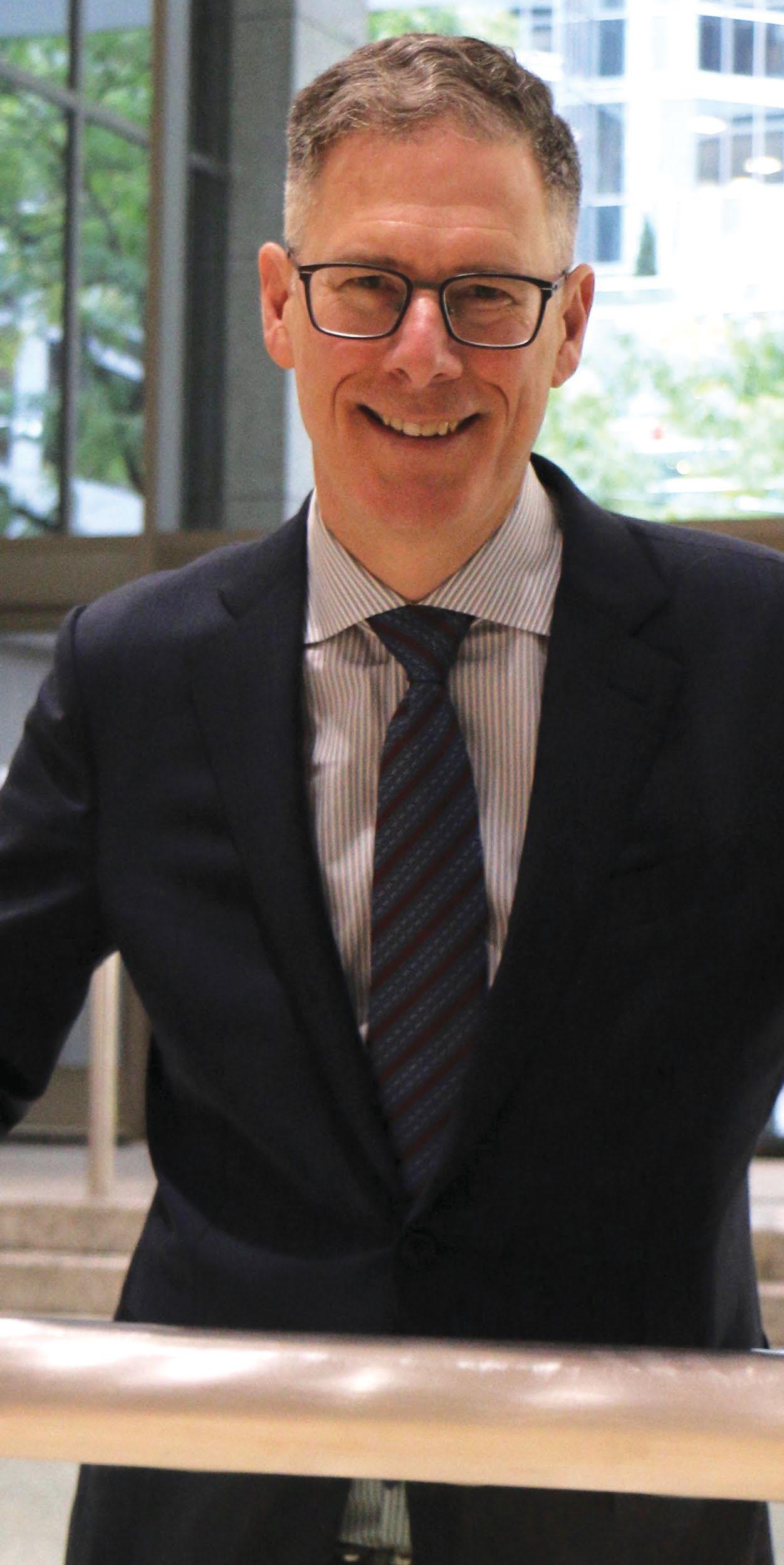
Estate Donations That Don’t Get Made
BY MALCOLM BURROWS
John Quinn was a corporate lawyer and Wall Street titan. A bachelor known for his many lovers, Quinn was also America’s first great modern art collector and tireless public champion. He was a friend of literary and art legends like Picasso, WB Yeats, and Joseph Conrad. Quinn died in 1924 of cancer with an 8-year-old Will. He was 54. His only beneficiaries were his sister and niece, neither who were close to him.
There are reports that Quinn had second thoughts about his estate plans just before he died. He wanted to keep his matchless collection intact, somehow. The problem was there was no museum willing to receive his challenging art — and Quinn had no faith that the public would be interested.
He wanted to establish a museum of modern art in New York City but was years ahead of his time. (Museum of Modern Art was founded in 1929 but didn’t have a building until 1939.)
Quinn owned hundreds of artworks, including masterpieces like Henri Rousseau’s The Sleeping Gypsy and Picasso’s Three Musicians. After a single lightly
10 FOUNDATION Magazine January/February 2023 foundationmag.ca
COLUMNIST
GARY TANNYAN
Malcolm Burrows
attended exhibition in New York in 1926 his executor sold the art at auction, mostly in Europe. And then US museums — including Museum of Modern Art — spent the next 50 years trying to track down and purchase the lost works. Charitable bequests that never get made — but could have with under different circumstances — are surprisingly common. I’ve had several personal experiences with donors and clients over the years.

There are a few recurring challenges. Reasons for Failed Gifts:
❯ Procrastination tops the list of estate planning sins. We all have time until we don’t. I had one client who spent three years planning a detailed charitable legacy — only to have her die without completing her new will.
❯ Societal expectations. Most cultures have strong expectations that family members are the only legitimate heirs. Charities, by contrast, are
beneficiaries that require thought, trust, and planning. Family members are conventional, default beneficiaries — even if the testator has no active relationship with them.
❯ Uncertainty about charities or charitable purposes. John Quinn was unable to identify an institution to accept his art. Sometime testators just don’t know which charity to support, which produces delays and failure. Uncertainty led Quinn to take the safe, conventional route of naming a family beneficiary.
❯ Lack of professional support. Getting expert support to plan and execute charitable donations is key. Lawyers who are experienced, practical, and efficient will ensure will get executed. They need to solve legal challenges — and to be supportive of the donor’s charitable spirit.
❯ Failure to name a foundation as a beneficiary. A foundation structure can help bridge gaps in time. It
can provide legal beneficiary and tax certainty while providing time to carry out the charitable purpose in the future. If Quinn had bequeathed his art to a foundation with instructions to find the right home for the art in the future, perhaps the collection would have been kept intact and put in trust for public purposes.
Sometimes the desire to make an estate donation runs smack into a wall of practical and emotional obstacles that would-be donor can’t overcome. It’s a constant challenge for estate planning professionals to understand true intentions — perhaps not fully articulate — and ensure they are acted upon.
MALCOLM BURROWS is a philanthropic advisor with 30 years of experience. He is head, philanthropic advisory services at Scotia Wealth Management and founder of Aqueduct Foundation. Views are his own. malcolm.burrows@scotiawealth.com. He writes this column exclusively for each issue of Foundation Magazine.
11 January/February 2023 FOUNDATION Magazine foundationmag.ca COLUMNIST
The Sleeping Gypsy (La Bohémienne endormie), Henri Rousseau, 1897, Museum of Modern Art
LEADERSHIP KATHLEEN PROVOST

Welcoming a New Era with a Human Touch
BY KATHLEEN A. PROVOST, CFRE, MAdEd
As a professional fundraiser, I believe we are in the “business” of building relationships, so I always seek to better understand how to improve these human relationships. Over the last few years, I have journeyed, as many of you, through numerous political and socio-economic factors that have impacted philanthropic relationships.
Today, I think we need to give priority to relationships and collaborations in an effort to co-produce learning and evaluations that can be shared and managed by fundraisers and donors. More importantly, I believe we need to commit to understand how each of our actions and strategy developments can result in furthering our mutual trust and accountability towards one another. This will ensure a healthy relationship by, maybe, giving our relationships a more “human touch”.
Responding in a different manner
In her January 12, 2023 Blog, entitled Hopes, Fears and A Wild Guess for 2023, Hilary Pearson caused me to reflect on key fundamentals of relationship building between donors and the charity they support. Pearson agrees with Phil Buchanan of the Centre for Effective Philanthropy when he said, “there is no dichotomy between strategy, assessment, evidence,
12 FOUNDATION Magazine January/February 2023 foundationmag.ca
COLUMNIST
Kathleen A. Provost
and learning on the one hand, and trust, listening and flexible support on the other”. In my opinion, this illustrates a natural evolution in the philanthropic relationship from a “business transaction” to a more “humanistic rapport” between donors and charities.
In Canada, the overlying challenges of recent years have forced philanthropic relationships to be more trusting, more flexible, and more responsive. This behaviour is also seen south of the border in the USA. Mackenzie Scott, American billionaire philanthropist and novelist exemplifies this trend towards more trustful relationships by donating more than $14 billion to some 1,600 non-profit organizations without any formal application process and no strings attached.
Looking at the two sides of the relationship
Current donors are placing a greater importance on developing mutual trust and embracing accountability. A number of charities and non-profits have demonstrated their ability to pivot in an attempt to address some of the problems that arose during the pandemic. Some charities and non-profits have both knowledge and expertise on key issues in our sector. With these new perspectives, we find ourselves in a new era of human interaction.
The human perspective of the donor
Donors generously make donations to solve problems. They want to feel their donation will make a difference because it gives them hope. Shared values in the philanthropic relationship will motivate donors to give. Hence, as we develop our relationship with a donor, it is imperative for us, the fundraiser, to explain the problem we are addressing as well as a proposed solution. By clearly conveying the impact the gift will make, it is possible to further develop accountability.
This later statement may sound obvious; however, the data says differently. In a November 2022 report, entitled 20 for ’23, Blakely and Leger along with Google conducted a research
in an attempt to discover emerging trends in the charitable sector between 2019 and 2022. They surveyed both Canadian & American donors. Blakely’s findings highlighted the need for charities to be explicit when proposing solutions to donors, so as to ensure trust is built. Many of these donors have also pivoted and continued to donate to charities during the pandemic and are now wondering: “What’s next?”
In their research, Blakely stated that “Eight in 10 donors feel charities will be important in solving some problems arising from the pandemic over the next few years.” Additionally, to building a trustful relationship, it is imperative to be accountable to these donors. Donors have agreed to be more flexible, or less controlling with their philanthropy in response to the pandemic, a behaviour sometimes referred to as the “bridge process”. Now these donors want to assess if their funds are addressing key issues which emerged during the pandemic. However, according the 20 for ’23 report, “49 percent of donors generally understand the problem, but not what the donation will solve. And 46 percent generally understand the problem and the solution but are unclear as to what the donation will be used for”.
The human perspective of the charity
The philanthropic sector is facing an
unprecedented demand for services, financial vulnerabilities, and a human resources crisis. Paired with current inflation rates and an eminent recession, we now find ourselves in the postpandemic era in which we need to develop news rules of engagement as we build our relationships. As our country reopens and we are heading towards a promise of normalcy, whatever the new normal looks like, I have concerns about how this period of intense stress has affected a charitable sector already dealing with high levels of stress and burnout.
On January 10, 2023 in The Philanthropist Journal, Surabhi Jain, Executive Director of the Workforce Funder Collaborative, said: “the nonprofit community, on the whole, needs to step up its game because the sector is failing to invest in the career development of its staff”. As a fundraiser, I am very much aware of the impact this pandemic has had in changing my relationship with donors. Given that our cultivation strategies with donors needed to adapt, I question if our sector also adapted. In my opinion, there are two specific areas of the charitable sector that needs attention.
First, I question if the individuals who work in this sector are being well equipped to do their work. We hear conversations about resilience, seen as a process of successfully adapting to challenging life experiences, especially through mental, emotional, and behavioural flexibility in an effort to adjust to external and internal demands. So, if we are to build relationships with donors, I wonder if all of us involved in the charitable sector, fundraisers, front liners, volunteers and other individuals have what we need to build our own resiliency? In an effort to work on my resiliency for instance, I started to paint. I do not think I will ever become an artist, but this activity has forced me to pause the “logistical side of my brain” in favour of using the “creative side of my brain”. It has helped me “reenergize” at times when I most needed it.
Second, I question if we are marginalizing certain groups within our
CONTINUED ON page 21
13 January/February 2023 FOUNDATION Magazine foundationmag.ca
COLUMNIST
Donors want to feel their donation actually makes a difference.
THINKING OUT LOUD MARYANN KERR
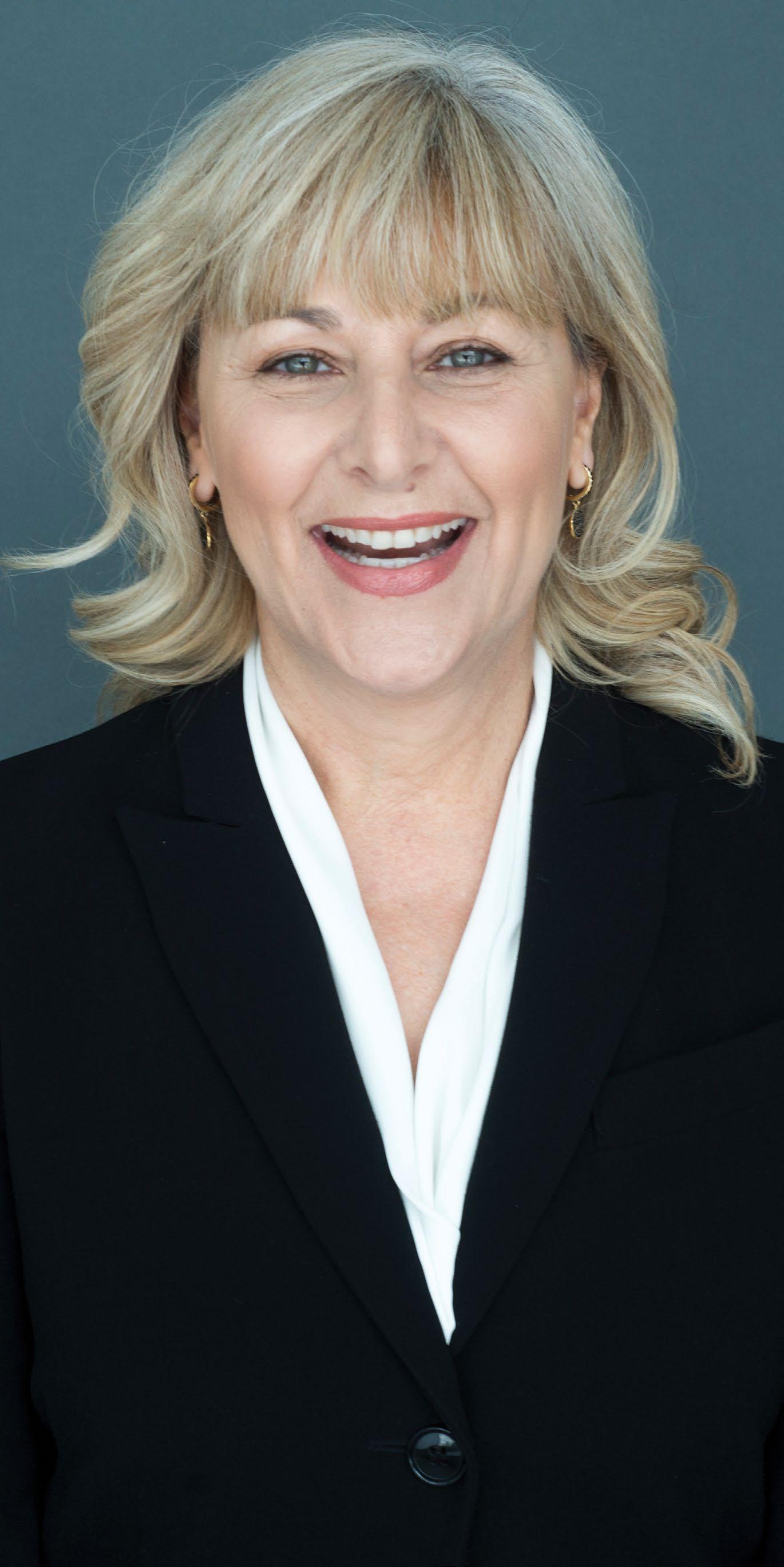
Raised To Be Nice
BY MARYANN KERR
If you have not watched the film Deconstructing Karen on CBC’s The Passionate Eye1, I highly recommend it. The film documents the work of Saira Rao2 and Regina Jackson3 Co-Founders of the Race2Dinner4. Race2Dinner’s mission:
… is simple — reveal the naked truth about RACISM in America and UNLEASH YOUR POWER as white people to dismantle it. This isn’t the stuff of Trump, the KKK and Nazis. That’s easy, it’s obvious and denouncing it requires almost nothing of white folks. What’s hard? Looking at yourself in the mirror and acknowledging that, as a white person in America, you are an active participant in upholding white supremacy. This isn’t personal. This doesn’t make you bad. This is systemic. This makes you human and an integral part of that system. Black, Indigenous and other People of Color are also part of the system. The truth is, we are on opposing sides: BIPOC are on the receiving end of white supremacy while white people are on the giving end. Until and unless white people are willing to disrupt white supremacy, we will never see change. White people: YOU have the power to disrupt and dismantle the hate.5
14 FOUNDATION Magazine January/February 2023 foundationmag.ca COLUMNIST
Maryann Kerr
We do indeed. The film speaks to the willingness of the facilitators to meet liberal White women where they are. This is an essential component of the anti-racism journey. So many of us were raised to be “nice” at all costs. That niceness is one of the reasons liberal White women are among the biggest deniers of racism — our own and that of others. It isn’t “nice” to call out racism and we believe ourselves to be “too nice” to be considered racist ourselves. It is a vicious cycle.
The Race2Dinner gives White women the opportunity to connect with systems that have raised them and taught them to be inherently and sometimes unconsciously racist. It isn’t a personal attack on the attendees, it is an eyeopening to understanding the experience of the global majority6 in a part of the world that operates within a system of white supremacy.7
The conversation, over drinks and dinner, provides a brave space to ask participants to start with themselves — to see their own racism. The hope, of course, is that dinner attendees will listen to and believe in the experience of folks from the global majority and be open to understanding the part they play in upholding an oppressive system. Perhaps, a few will even go on to be actively antiracist — to rage against it — within their own circles of care, communities and places of work and worship.
Over dinner it is suggested that coming to terms with our own racism is hard. This proves true, to varying degrees, for the women in attendance. Acknowledging our own racism flies in the face of our belief in ourselves as good, kind, nice people. It isn’t hard for everyone. Some folks came to an understanding quicker than others and immediately understood they are complicit. For others, being so deeply rooted in their ‘niceness’ and belief that all discourse should be pleasant and polite, never moved far beyond a defensive stance.
The film is filled with powerful moments. At one point, the facilitators suggest that if any of the women feel the need to cry, they should leave the
table and go to the next room where they would find tissue. This was hard for some to understand. Was this not a ‘safe’ space where they could feel free to express their feelings? No, not exactly. It is a brave space where the focus needs to stay the issue of racism and not on how you feel as you confront your own. This is commonly referred to as White fragility.
Racism is alive and well in our sector. At present, the folks talking about it are primarily from the global majority. Sometimes this makes sense. However, as the Race2Dinner mission statement suggests, as part of the dominant White culture, those of us who are White presenting have a responsibility to disrupt and dismantle the status quo. We need to look inside and recognize that we are products of our upbringings, our current environments, our education, and we must rage against all the biases we’ve inherently adopted.
At times, I’ve taken a beating on social media because I still believe this work can be done in a manner that doesn’t isolate, intimidate or crush another. This isn’t me being a White moderate or wanting to play nice. Though that is definitely part of who I am. It is simply that, if we want to avoid the natural response that is defensiveness in these conversations — we need to have hard conversations with compassion just as they do in the Race2Dinner
The facilitators were genuine, authentic and firm. They were not always ‘nice’ but they were kind. And oh, the patience. How many times have they said the same thing over and over again? How many times have they felt the sting of defensiveness, shock, disbelief and denial? How many times have they valiantly shared their lived experience only to be met with skepticism and cries of “no, not me.” I wonder if it is sustainable.
Don’t get me wrong, this isn’t about centring White women, or showing more compassion for their fragility than the experience of Black women in the world. It is about desperately wanting to make progress. I hope you’ll watch the film and take the learnings into your own conversations. I hope you’ll watch and recognize that having a Black friend, partner, child… doesn’t make you less racist. I hope you’ll watch and then BE different. I hope you’ll watch and realize that if you are White presenting, to be called a White woman, is not an insult and is not creating division — it is simply naming you what you are8.
Watching this film and now reading the book White Women: Everything you Already Know About Your Own Racism and How To Do Better, by Saira Rao and Regina Jackson9 has revived some long faded hope that perhaps the world is moving towards a more equitable, less violent future. Now Shhhh….time to watch and listen.
MARYANN KERR is Chief Happiness Officer, CEO and principal consultant with the Medalist Group. Maryann is a governance, leadership and culture specialist, has worked in the social profit sector for 34 years and helped raise over $110M. She is an associate consultant with Global Philanthropic Canada. Maryann is a sector leader with a passion for her social justice, feminism, and continuous learning. Maryann’s first book was published by Civil Sector Press in 2021: Tarnished: Let’s rethink, reimagine and co-create a new social impact sector. Maryann earned her CFRE in 1997 and her master’s in organizational leadership in 2016. She is currently exploring opportunities for a Ph.D. or perhaps a second book. She writes this column exclusively for each issue of Foundation Magazine.
1 Deconstructing Karen The Passionate Eye (cbc.ca)
2 Saira Rao | LinkedIn
3 Regina Jackson LinkedIn
4 Race2Dinner: Overview LinkedIn
5 Ibid
6 GLOBAL MAJORITY English meaning - Cambridge Dictionary
7 WHITE SUPREMACY | English meaning - Cambridge Dictionary
8 Why Is The Phrase ‘White Women’ Triggering For Many White Women? (forbes.com)
9 White Women - Race To Dinner (race2dinner.com)
15 January/February 2023 FOUNDATION Magazine foundationmag.ca COLUMNIST
We need to have hard conversations with compassion.
Chamberlin
MARKETING & FUNDRAISING SARAH CHAMBERLIN
 BY SARAH CHAMBERLIN
BY SARAH CHAMBERLIN
Happy 2023! I am proud to kick off this year with some exciting news from CAMH Foundation: On February 7, the Centre for Addiction and Mental Health (CAMH) publicly launched No One Left Behind, the largestknown fundraising campaign for mental health. With an ambitious $500-million goal, No One Left Behind is the final phase of CAMH’s decades-long effort to change mental health care forever.
We know that mental health has always lagged behind other areas of medical research and care. Lack of understanding, lack of advocacy, and lack of investment have fostered a culture of stigma, silence, and shame. For the past quarter-century, CAMH has
No One Left Behind
CAMH Launches $500-million No One Left Behind Campaign for Mental Health Research
been a leader and a beacon of hope for the growing mental health movement. Because here we stand together. We bring one another strength. We search for answers that don’t yet exist. And with the support of our community, we’re building a future where no one is left behind.
Our history — from an asylum to a modern patientcentered health care facility — is the history of mental health care in Canada. From the Provincial Lunatic
16 FOUNDATION Magazine January/February 2023 foundationmag.ca
Sarah
COLUMNIST
Asylum in 1850, to the Centre for Addiction and Mental Health (CAMH) in 1998, we remember where we’ve come from. It’s important to reflect on how far we come, at the same time as we acknowledge how much more progress is needed.
CAMH has been on a 20-plus year journey to reimagine our home at the Queen Street Campus. Moving from institutionalization to integration, we have worked hard to evolve within the community. In 2020 through the help of philanthropy, we opened two new, state of the art patient care facilities, the McCain Complex Care and Recovery Building and the Crisis and Critical Care Building. We are now ready for the final piece of the puzzle, which will enable us to bring all aspects of mental health care together — a necessity when aiming to improve outcomes for those living with mental illness.
We believe that research is how we are going to solve the global mental health crisis. Through brain imaging, genetics, big data, new drug development, and much more, we will create a space that is more inclusive and dignified; a space that will allow us to accelerate the work we’re already doing and guide us to new breakthroughs. At the heart of the campaign is our goal to build the CAMH Research & Discovery Centre — the place where we will develop new ways of detecting, treating and preventing mental illness, and fuel the people and programs that will deliver more personalized treatments and equitable care.
The 375,000 square feet of collaborative space will allow us to increase the number

of CAMH researchers, scientists, staff, students, and trainees by 43% and add six new multi-disciplinary research teams to explore uncharted areas of inquiry. Support for this campaign will enable new breakthroughs that improve care in critical areas of research, including: brain science, to unlock the mysteries of the brain and discovering the causes and cures of mental illness; child and youth mental health, to diagnose and treat mental illness sooner to give every young person the chance to thrive; late-life mental health, to stop dementia before it starts and help people age with dignity and hope; precision medicine, to personalize mental health care so everybody gets the right treatment at the right time; and health equity, to eliminate disparities and break down stigma, thereby creating a world where mental health is health for everyone.
We all have someone that comes to mind when reading that impressive list of the work that’s already underway, spanning the lifespan and communities we serve. Someone that would greatly benefit from new discoveries, or new treatments, or earlier intervention. I come to work every day, powered by the hope of a future where mental health is health. I’m inspired by each and every person’s story of recovery that I hear, inevitably with a poignant note of gratitude. I’m in awe of the incredible work that our CAMH teams accomplish day in and day out—all with the goal of having no one left behind. Knowing that we are actively uncovering new methods of care and impacting the lives of patients
each and every day gives me hope for the people in my life and the people in yours.
In anticipation of the public launch, more than $400 million in donations and pledges has been secured through philanthropy since the beginning of the campaign’s quiet phase in 2018. This total raised over the past five years is more than CAMH has raised in the previous 20 years combined.
I have been at CAMH since 2019 and I can confidently say that this is the proudest and most exciting time of my career. With the help of our partners at Camp Jefferson, we’ve had this campaign in progress for a number of years. I like to think of it as the final evolution of our previous campaigns. In 2020, we started a very necessary and overdue conversation on suicide with Not Suicide, Not Today. More recently, we showed the world how mental health research is saving lives Today. Now, it’s time for us to rally the support of our community and come together to build a future where there is No One Left Behind.
Join us and change mental health care forever. Visit camh.ca for more information.
Please visit CAMH.ca to read more about the important work CAMH is doing with the help of our communities or email Sarah at sarah. chamberlin@camh.ca. She writes this column exclusively for each issue of Foundation Magazine
17 January/February 2023 FOUNDATION Magazine foundationmag.ca COLUMNIST
SARAH CHAMBERLIN is Chief Marketing Officer and Vice President of Community Giving and Engagement at CAMH Foundation. The Foundation supports the philanthropic efforts of CAMH, Canada’s largest mental health teaching hospital and a world leader in mental health research, treatment, and advocacy.
Building a home for innovation. The CAMH Research & Discovery Centre will allow us to fuel more change, faster than ever before.
COURTESY CAMH
THE ACCIDENTAL PHILANTHROPIST MARK HALPERN
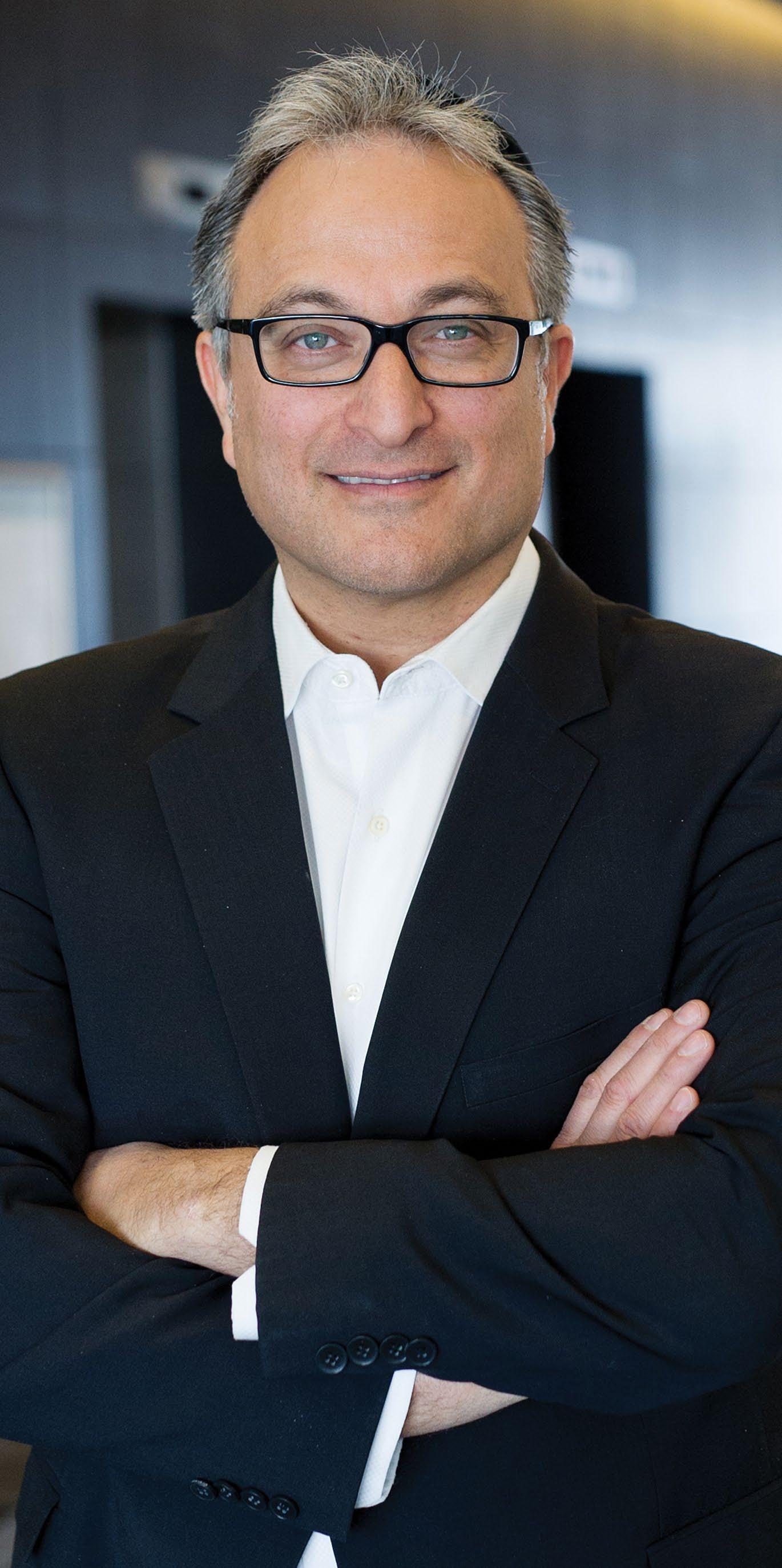
The Philanthropic Powers Of Life Insurance
BY MARK HALPERN, CFP, TEP, MFA-P
In my 31 years of professional practice, I’ve had the good fortune of helping many successful business owners, entrepreneurs, incorporated professionals, and affluent families. A lot of my work has involved collaborating with their allied professionals specializing in accounting, tax, insurance, investments, and law.
My single biggest takeaway is this: Everyone knows what Life Insurance is, but very few people know what Life Insurance really does
They mistakenly believe that Life Insurance is only there to replace income, pay off a mortgage, keep food on the table for their families, and protect their kids’ ability to get a good education. At the start of their careers, it was a necessity, much like car insurance or property insurance — but now that they’ve made it, they say it isn’t important.
What most people don’t know is that Life Insurance is an extremely flexible tool that complements all the other financial planning strategies they have in place. It has myriad applications, especially for people who have wealth to protect and are interested in creating a legacy for their families and the charitable causes they support.

FOUNDATION Magazine January/February 2023 foundationmag.ca 18
COLUMNIST
Mark Halpern, CFP, TEP, MFA-P
This article illustrates just a few of the many ways that Life Insurance can be leveraged to support two key goals shared by many high-net-worth individuals — to pay less tax and leave a bigger legacy. I’ll use a typical client example, but keep in mind that each of these strategies can be customized and targeted to achieve very specific objectives.
From success to significance
Bob and Cindy built a thriving business from the ground up. They are 63 and 60, with four children and eight grandchildren. They are pillars of their community and support their local hospital and various other charitable causes.
Their net worth of more than $120 million consists of real estate investments and corporate assets. Their current planning includes a very generous (and unintentional) tax liability of $25 million, due after the second spouse dies. That bill can be funded in several ways. Three of the most common are:
❯ Using cash on hand – though this would require $41.2 million in pre-tax cash from the corporation, assuming the eligible dividend tax rate of 39.34 percent.
❯ Borrowing – but an estate may struggle to access that much credit, and high interest rates may take a big bite out of inheritances. As well, the interest is not deductible, and the loan must be paid back.
❯ Selling assets – most people don’t want to risk a “fire sale” that doesn’t provide fair market value, as well as the fact that there are many additional tax consequences when assets are sold.
Fortunately, there is a fourth and better option. Dedicating a Life Insurance policy to the task of paying estate taxes, which is usually much less expensive and more tax effective. Life Insurance, when corporately owned, can be paid for with cheaper after-tax corporate dollars. It also provides a mechanism for getting money out of your corporation tax-free through the capital dividend account (CDA).
1Cover the tax bill
Purchasing a $25 million Life Insurance policy will take care of the taxes for a lot less than doing nothing. Funding options include an annual premium of $334,592 payable for life, an annual premium of $372,935 payable to age 85, or an annual premium of $675,000 payable for 10 years only. The highest amount this couple could pay after 10 years is $6.75 million — vastly less expensive than $41.2 million.

2 Cover the tax bill with financing
It’s also possible to acquire a $25 million Life Insurance policy in a manner that’s cash flow neutral, using the Immediate Financing Arrangement (IFA) strategy. A policy’s cash surrender value (CSV) is welcomed as security by all Canadian chartered banks. If Bob and Cindy are comfortable with financing, they can pay the premiums and immediately borrow back up to 100 per cent of the premiums paid, and invest the loan proceeds.
Because the money gets invested, they can deduct the interest expense. This arrangement can be structured in a cash flow neutral manner, and their estate still receives the full $25 million to take care of the estate taxes. If the insurance policy is corporately owned, their corporation receives an additional Capital Dividend Account (CDA) credit of $24.8 million, allowing a future tax-free withdrawal of $24.8 million for the next generation.
3Cover the tax bill and maximize charitable giving
We are dealing with a very community-minded couple who want to leave a significant charitable legacy. They can leave a big gift, at the same time eliminating estate taxes. By buying a $50 million Life Insurance policy at a cost of $1.3 million annually, the total cost will only be $13 million, payable over 10 years. At death, the estate will receive the money and donate it to the couple’s charitable foundation — generating a $50 million tax credit that mitigates the estate taxes and turns it into charity instead.
4 Cover the tax bill and maximize charitable giving, with financing
This strategy can also be made cash flow neutral. Just as in strategy number 2 above, Bob and Cindy can pay the premiums and immediately borrow back the policy’s CSV, invest that money, and deduct the interest expense. In this case, the charity receives the full $50 million, entirely offsetting the estate taxes. Again, assuming this is a corporately owned policy, the corporation gets an additional CDA credit of $49.7 million.
5 Generate cash flow for a charity with the GiftMAXIMIZER™ strategy
People think that Life Insurance only provides a benefit when the insured dies. But there are actually two ways to benefit from Life Insurance for charity while the insured is alive! We call this the GiftMAXIMIZER™ strategy.
Our generous couple can donate, for example, $500,000 annually to their foundation, Donor Advised Fund or directly to a charity for 10 years. Their total net cost after the annual charitable donation tax credits amounts to $2.5 million. The foundation can use the funds to pay premiums on a joint last-todie Life Insurance policy. Dividends paid out from permanent Life Insurance are usually used to buy Paid up Additions, which increase the death benefit and CSV. But the dividends can be taken out as
19 January/February 2023 FOUNDATION Magazine foundationmag.ca COLUMNIST
Five ways Bob and Cindy can use Life Insurance to pay estate taxes — and more ISTOCK/ MONKEYBUSINESSIMAGES
Sage Intacct cloud financial management platform for nonprofits
It's time to thrive
The nonprofit financial management platform that lets you pursue your mission more efficiently
The nonprofit accounting software that lets you

purse your mission more efficiently
Fast consolidations to manage your organization’s complexity
With push-button consolidations, you get fast closings and real-time analytics—in minutes, not weeks—for maximum impact on your nonprofit’s performance.
As the #1 cloud financial management and accounting solution, Sage Intacct delivers the automation and controls around billing, accounting and reporting that finance needs to reduce errors, say audit-ready and grow your nonprofit.
Sage Intacct’s multidimensional database lets you aggregate transactions and activities across your organization:
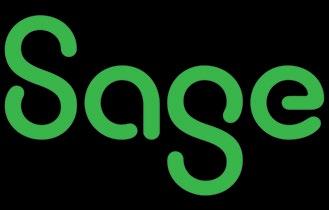
• Manage monies by grant/donors, programs, geographies, and other dimensions
• Achieve a granular level of accuracy
How can your nonprofit achieve efficiency and clarity when you’re operating different legal entities with different currencies and different tax jurisdictions? Forget the headaches of spreadsheets and manual reconciliations.
• Set budgets for each event, campaign, program, and funder
Multiple entities
Multiple currencies
• Track the actuals to create tighter controls and prevent unexpected outcomes
• Manage capital budgets
Learn more about Sage Intacct. sage.com/ca/nonprofit
Learn more at sage.com/ca/nonprofit
Multiple grants and donors
Multiple locations
The nonprofit accounting you purse your mission
cash dividends and given to charity every year tax-free.
Starting as early as the first year of the policy, the charity can begin to receive annual tax-free cash dividends. But waiting until year 10 means that those dividends won’t reduce the legacy gift on death. At that point, the charity can begin to receive annual tax-free cash dividends that start at $162,000 and increase annually until the second spouse dies.
In the end, in exchange for a net investment of $2.5 million over 10 years, the charity could receive $5 million of annual dividends and a substantial legacy gift on death of $7.7 million in insurance proceeds. That’s $12.5 millions of charity at a cost of $2.5 million.
Much more than income replacement
We meet many people with great advisors working to build customized financial, tax and estate plans for them. But it’s a rare client who has a coordinated team working to implement the most effective strategies across every discipline.
We love to collaborate with other specialists, including accountants, lawyers, investment advisors, family offices and insurance advisors. Doing so allows us to share our expertise in personal and business insurance, estate planning and philanthropic planning, and help clients achieve their unique goals.
Get professional help
Don’t go it alone. Get the benefit of experience and knowledge from a team of seasoned insurance professionals who can assess your needs and suggest appropriate strategies. Get the right types of insurance in the right amounts, with the help of professionals who will be there to advocate for you in the event a claim is made.
MARK HALPERN is a well-known CFP, TEP, MFA-P (Certified Financial Planner, Trust & Estate Practitioner, Master Financial Advisor – Philanthropy). He was honoured to speak in the Disruptors Category at Moses Znaimer’s most recent ideacity conference. His talk generated high interest and comments. Watch “The New Philanthropy” at bit.ly/MarkHalpernTalk Learn more at www.wealthinsurance.com. He writes this column exclusively for each issue of Foundation Magazine.
Welcoming a New Era with a Human Touch
CONTINUED FROM page 13
charitable sector workforce. A recent Imagine Canada report, Diversity Is Our Strength, reveals that women make up more than 75 percent of the non-profit workforce. The report also states that nonprofit workers are more highly educated than those in the broader economy. However, those working in communitybased agencies earn an average annual salary of $38,716 compared to $57,137 economy-wide. This makes me question if our own sector continues to marginalize women. This argument could also be made for immigrants, Black, Indigenous, racialized, and older workers. If aligned values between donors and charities are a key motivator for donors, then aligned values like pride and hope will influence the relationships we are trying to build.
Providing a bit of optimism
Albeit all these factors I just mentioned, I remain optimistic for our sector. Like many of us over the past few years, Laura Frye, Senior Major Gifts Officer at “From the Top,” a non-profit NPR program nurturing the talent of young classically trained musicians, illustrated what happened when she said, “the pandemic forced the group to cancel or adapt much of its in-person programming but also proved the resilience of From the Top’s team and donors”.
Amid the uncertainty ahead, and by focusing on the human values we have honed over the last few years we can get through some of the post pandemic related uncertainty. Active listening will help us through these challenges, so listening to our donors, continuously, adapting to donors’ preferences, and asking donors about their individual circumstances may enable us to incorporate trust and accountability into our relationships towards one another. This is also true for our working relationships with the charitable sector.
Maybe this means having a more “human touch” in our relationships.
My final thoughts
The charitable sector continues to face stress every day, but the unprecedented experiences we have had in the last years have taught us to shift into neutral and take a moment to “check-in” and understand what’s happening. This new era is forcing our sector to be a little more “human” with regards to relationship building, which is at the core of our philanthropic activities. Building trust and accountability leads to “success” for individuals involved in making a donation as well as those involved in problem-solving.
As Nancy Pole mentioned in her article entitled Measuring and accounting for ‘success’ in the charitable and non-profit sector: “changes are underway in the non-profit and charitable sectors and in their relationships with partners and communities. In the last few years, the needs, aspirations, and calls for justice of equity-seeking communities have begun to receive long-overdue attention”. Pole talks about working in an increasingly complex funding ecosystem of delicate relationships with ongoing tension.
We are attempting to satisfy individual and social needs while developing new rules of engagement. As a result, it will be possible for charitable organizations and non-profits, and their allies to build healthy relationships in a way to reconcile different stakeholders’ needs. Maybe, by adding a little human touch, we can aspire to build healthy relationships based on trust and accountability.
KATHLEEN A. PROVOST, CFRE is currently the Director, Campaign Initiatives at St. Francis Xavier University, in Antigonish, NS. She brings over 25 years of fundraising experience within the charitable sector. She has been a Certified Fundraising Executive (CFRE) since 2007, and a long-time member and volunteer for the Association of Fundraising Professionals (AFP). As a recognized leader, Kathleen has tailored presentations and workshops for French and English audiences at various events including AFP-Nova Scotia, AFP-Ottawa, AFP-National Congress, Coady International Institute and the Canadian Council for the Advancement of Education. Kathleen is a McGill University graduate and holds a Master, Adult Education from St. Francis Xavier University. She has received numerous recognitions during her career, including the Queen Elizabeth II Diamond Jubilee Medal for her contributions to the charitable sector and 2021 Fundraiser of the Year in Nova Scotia. She writes this column exclusively for each issue of Foundation Magazine.
21 January/February 2023 FOUNDATION Magazine foundationmag.ca COLUMNIST
Nurturing a Culture of Volunteerism
 BY HEATHER BAKER
BY HEATHER BAKER
It takes more than inspiring speeches and altruistic plans to make an impact. Genuine change — the kind that betters lives and builds communities — requires people who are willing (and able) to commit their time, resources, and talents to making that change happen.
The importance of volunteering is not lost on Canadians. In 2018, Statistics Canada took a snapshot of volunteer activity in the country and found that almost 8 in 10 Canadians (aged 15 and older) volunteered and gave five billion hours of their time to make the country a better place. As Social Impact Leader with KPMG in Canada, I have witnessed colleagues across the country dedicate their energies to social justice initiatives, charitable fundraisers, and life-changing community programs. Their work varies greatly, but these individuals share a common understanding that change can only happen with people who are willing to put in the work.
Organizations also thrive in a culture of volunteerism. In my experience, people who feel empowered by their employers to make a difference in their community experience personal growth by learning new skills, forming new community relationships, and gaining diverse perspectives on pressing issues. As a result, they come to work with a greater sense of place and purpose, serving as sources of inspiration and morale among their peers. Moreover, volunteers are the beating heart of an organization’s community ESG commitments, and instrumental in forging community relations at the ground level. For these reasons and more, KPMG’s Social Impact Strategy is designed to create a purpose-led and values-driven culture for our people, one in which individuals can find the inspiration and supports to make a difference in issues and causes that matter most to them.
The case for volunteering has always been clear. But the reality of the last few years has made traditional volunteering very difficult. Much has happened since Statistics Canada conducted its volunteer survey in 2018. That includes a global pandemic which put a quick and decisive end to in-person volunteer activities on its arrival and continues to make it difficult for former volunteers to return. As referenced in a 2021 Foundation Magazine article, studies like Human Resources Impact of COVID-19 on Canadian Charities and Nonprofits (by Charity Village and the Portage Group) also show that two-thirds of charities and nonprofits (64 percent) surveyed have experienced a decrease in the number of volunteers since the start of the pandemic in March 2020, and 26 percent of these lost over 75 percent of their volunteers in a year.
KPMG is not immune to this trend. Over the past two years, our volunteers have also been challenged to maintain their community work amid public health restrictions, economic pressures, and shifting priorities. So while I am extremely proud and grateful to report in Our Impact Plan: Canada that some 1,180 Canadian team members dedicated more than 36,000 volunteer and pro bono hours in 2021, I know growing that impact will not come easy. To that end, I believe anything an organization can do to promote and empower volunteerism among its ranks will benefit all.
Lighting the spark Volunteerism thrives when people have support to explore their passions. Organizations play an important role in providing that support; and within our halls, KPMG has found the following strategies to be the most impactful:
❯ Flexible workdays. Volunteering takes time, and for many

FOUNDATION Magazine January/February 2023 foundationmag.ca 22 VOLUNTEERISM
ISTOCK/ MELITAS
people, finding the extra hours outside of a typical work day can be tough. Here’s where organizations can ease the crunch by enabling people to negotiate work schedules that allow them to volunteer while still delivering on their responsibilities.
❯ Financial incentives. There are different ways an organization can financially support its people’s volunteer work. For example, through KPMG’s Financial Support for Volunteering program, our people can apply for a donation to a Canadian not-for-profit or charitable organization as recognition for the hours they volunteer.
❯ Pro bono. KPMG is investing $500,000 in pro bono services to support projects led by Indigenous organizations that will have an impact on the protection of nature and biodiversity. These projects will be supported by KPMG people by using their skills and passion.
❯ Continuous learning opportunities. In addition to financial incentives and support, there is value in providing volunteers with additional training and education resources. Learning about the issues and the tangible impact of their volunteer work inspires volunteers to do more and derive more meaning from their efforts.
❯ Internal opportunities. Provide ways at work for people to apply their skills and passion while also advancing the firm’s social, environmental and Inclusion, Diversity and Equity commitments (e.g., participating in KPMG’s Green Champions Network, Leaders of Tomorrow Circle, Sustainability Committees, People Networks, etc.).
❯ Using technology. Volunteer platforms can make it easier to coordinate, track, and measure volunteer activities across an entire workforce. We’re implementing an application that will help to connect our people with volunteering opportunities and provide deeper insights on activities across the country. It contains a hybrid of in-person and virtual volunteer opportunities in a variety of community organizations and causes, as well as opportunities to volunteer for internal social impact and environmental committees, and information on sessions to learn more about community issues and organizations.
❯ Team building. For some, volunteering is more fun and
approachable in numbers, particularly as employees are coming back to the office. Over the years, our firm has found that using volunteer activities as team-building events gets people interested in volunteering or opens their minds to volunteer opportunities they had not considered.
❯ Shining a spotlight. Part of supporting volunteers is celebrating their work. We have experienced success doing so in our annual KPMG Impact Awards. In 2022, we presented 47 national and regional awards to more than 160 individuals and team members across our firm, and donated $70,000 towards the award recipients’ charities of choice to help advance their mission.
❯ Sharing stories. Sharing volunteer stories and successes (e.g., internal communications, town halls, newsletters, and social platforms) drives volunteer engagement and inspires other team members to follow suit, as well as inspire others outside our firm.
Organizations can also lay the groundwork for volunteering activities by forming national or local community alliances. In 2019, for example, KPMG joined forces with Food Banks Canada to pilot volunteer tax preparation clinics in which KPMG people help food bank users file their taxes and obtain available government supports, as part of the Canada Revenue Agency’s Community Volunteer Income Tax Program. In addition, KPMG teams did pro bono work to help streamline the tax filing intake process and created the technology platform to accommodate virtual volunteering for KPMG people and community volunteers, which was particularly beneficial during the pandemic. Meanwhile, 2022 marked a significant year for this program. Through our support of the initiative, tax clinics in Saskatoon, Mississauga, Windsor, and White Rock, returned $18.2 million to people in the local community — and completed 4,492 tax returns, doubling the impact from 2021.
Another example is KPMG’s Greater Vancouver Area office and First Book Canada working together for the Family for Literacy program in which firm volunteers gift a book to every student at a participating elementary school and join them for a day reading in their classrooms. Initiatives like these and others throughout our more than 40 offices across Canada are making real impacts, and they all began with identifying a social need and matching it with our people’s skills or passion.
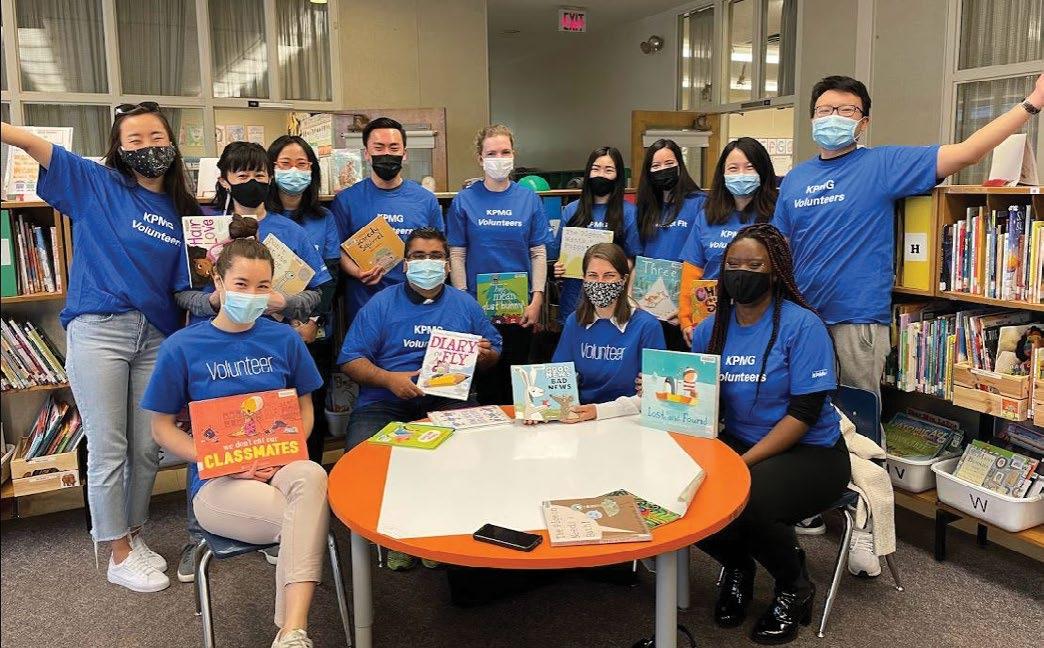
Each journey is unique
The upsides of volunteering are hard to dismiss. Even so, creating and maintaining a workplace where people are inspired and empowered to make a difference outside of their jobs is no small ask — especially in a time when finding individuals to fill paid job positions can be a challenge unto itself. I hope that by sharing our volunteer stories and engagement strategies, I can help effect change beyond KPMG’s doors.
foundationmag.ca 23 January/February 2023 FOUNDATION Magazine VOLUNTEERISM
HEATHER BAKER, FCPA, FCA, is Canadian Managing Partner, Quality and Risk Management and Social Impact Leader, KPMG in Canada.
KPMG’s Greater Vancouver Area office and First Book Canada working together


Examining Quiet Quitting in the NFP Sector
BY JASON EGBUNA
Over the past couple of years, a variety of things in the workplace have changed. Remote work became more

prevalent as a result of COVID-19, layoffs increased, and we saw the rise of what has been termed “quiet quitting” — which essentially involves not outright quitting a job, but definitely not going above and beyond within a designated role.
The Not-for-Profit (NFP) sector wasn’t isolated from this trend, as many organizations saw some staff moving away from the additional hours and tasks that are commonly accepted as the industry standard. Individuals began re-examining what was important to them. As work-life balance came to the forefront and salaries started to increase in other sectors, NFPs found themselves in a challenging position of attracting and retaining top talent.
To take a step back, it’s important that we look at what “quiet quitting” — also referred to as “coasting culture” — really looks like. Some of the clear markers that should stand out for employers include:
❯ Maintaining a strict 9-5 workday
❯ Disengaging from colleagues
❯ Using more sick and personal days
❯ Demonstrating reluctance to return to the office, for those who have been working remotely
❯ Showing less enthusiasm about work
❯ Not seeing the value in organizational culture

FOUNDATION Magazine January/February 2023 foundationmag.ca 26 STAFFING
ISTOCK/ KERKEZ
It is important to note that just because an employee demonstrates one of the points mentioned above, it doesn’t necessarily mean they are quiet quitting.
But how are NFPs to know if they are engulfed in an employment phenomenon where these indicators are present, or if the current temperature is instead a result of possible job dissatisfaction and years of burnout in the sector?
The City of Vancouver echoes this line of thinking, stating that “Vancouver organizations are struggling with staff absences,” which is “a symptom of decades of underinvestment in non-profit capacity.” This may ring true to most individuals who work in NFP organizations. The notion of “doing more with less” has been such a common refrain within organizations, it should almost be part of various mission statements. With staff handling excessive workloads and management relying on what is often an employee’s strong orientation towards the cause it has resulted in a work environment in which NFP employees are at high risk of burning out.
Also, factoring into the conversation around quiet quitting is whether salaries in NFPs are competitive in today’s landscape. Some would argue that if you’re going to be overworked, you might as well be getting paid well for it — and it’s a strong argument. As many employees started examining their place in the NFP world, it became apparent that there is more of a gap in salaries at many NFPs than originally believed. According to Imagine Canada, average salaries in community NFPs are 35 percent lower than the economy-wide average in Canada and while 58 per cent of NFPs said they are going to increase wages for existing employees and 31 percent for new employees, they are starting from a significant salary deficit, creating an unbalanced competitive landscape.
With the high work plus low pay equation prevalent in many NFPs, we’re left to wonder: is the sector more susceptible to quiet quitting than others? The NFP sector hasn’t always been the most willing or quick to change workplace structures and cultures in order to offset some of the downsides to attract and retain staff. Consider the observations below:
❯ Unpaid event attendance and participation is more often the norm than the exception
❯ Diversity at the leadership level could be improved
❯ Only 36 percent of NFPs have some sort of Employee Assistance Program
Without mindsets and cultures changing, where a positive future
can be seen for staff, it could be a tough horizon for NFPs. More than ever, if staff don’t see a clear career path and feel supported on that journey, they are going to explore their options.
It’s not all doom and gloom for NFPs. One of the ways in which the sector is actively making strides is in staff training and development. Recent reports show that 40 per cent of NFPs plan to provide staff with paid time to engage in learning and development programs (compared to 14.3 percent in the private sector), and 34.2 percent plan to encourage employees to participate in on-the-job training (26.6 percent in the private sector). While this is very encouraging news, what tempers these efforts is the tendency for NFP roles to continue expanding, where staff assume additional responsibilities (some without proper training), which creates additional stress.
Quiet quitting in the NFP world really isn’t anything new; it’s just a new name for an existing problem that the pandemic has amplified, as individuals assess what they want from their career and in their lives. But that’s no excuse not to work on a plan to move forward.
Below are some simple strategies that NFPs can work on implementing or improving that can help them become more positive, welcoming, enjoyable and successful workplaces: Be flexible: NFPs should examine if a 9-5 schedule is necessary for all staff. Let’s not forget that this was originally implemented in 1926. More focus should also be placed on the quality of work versus hours “in the office”
Model work-life balance: While it’s a great catchphrase, senior leaders should adhere to it and demonstrate its importance. With more people working remotely, the lines between work and life outside of work have been blurred. Senior leaders need to define and maintain boundaries
Review employee benefits: Examine the organization’s benefits and determine what can be strengthened or added to make the workplace more competitive and attractive
Communicate: Provide staff with a clear vision of a career at the organization, not just an isolated job. People want to feel like they are part of a team and have an opportunity to grow within an organization
Check in: Different staff members will deal with challenges in the workplace very differently. Leaders within NFPs should check in on teams to see how each staff member is doing. When issues are raised, leaders should ensure that they are put into action and that feedback is provided.
foundationmag.ca 27 January/February 2023 FOUNDATION Magazine STAFFING
JASON EGBUNA is Marketing Manager, Major, Estate & Leadership Giving Princess Margaret Cancer Foundation.
We’re left to wonder: is the sector more susceptible to quiet quitting than others?

ISTOCK/ TASHKA
how funders Can help grassroots and nonprofitsindigenous-led thrive using technology
BY SEVETRI WILSON
Small, grassroots nonprofits have long been the heartbeat of communities. Many of these organizations are BIPOC-led — meaning the leadership identifies as Black, Indigenous, or People of Color. Unfortunately, BIPOC-led organizations often receive the least support.
The statistics tell a stark story.
Despite accounting for 3.5 percent of Canada’s population, Black-led and Black-serving community organizations have been severely underfunded by the nation’s foundations, according to Unfunded: Black Communities Overlooked by Canadian Philanthropy, a report published by the Network for the Advancement of Black Communities and Carleton University’s Philanthropy and Nonprofit Leadership program.

Black-led groups received only 0.03 percent of funds in the 2017 and 2018 fiscal years, and Black-serving organizations received only 0.15 percent of funds in the same timeframe.
Also among underfunded nonprofits are Indigenous-led organizations which play critical roles in bolstering Indigenous communities. In Canada, charities serving Indigenous peoples receive only 1 percent of overall donations, although Indigenous peoples comprise 4.9 percent of the population, according to Alliance.
foundationmag.ca 29 January/February 2023 FOUNDATION Magazine TECHNOLOGY
TECHNOLOGY
Indigenous-led nonprofits face a multitude of unique challenges
Foundations that do give to Indigenous-led nonprofits most often provide only intermittent support, making long-term relationship-building between Indigenous communities and the philanthropic sector challenging.
‘Overlooked,’ a report published by Candid and Native Americans in Philanthropy, shows that “Native American nonprofit leaders report having less positive experiences with their foundation funders than nonprofit leaders of other races/ ethnicities.”
Further, the report finds that “Despite the significant challenges facing Native American people, most foundations continue to overlook nonprofits that serve Native American communities.”
There are numerous ways to support these organizations better. Findings by Investing in Native Communities show how funders can be more effective partners with Indigenous communities. The outlined recommendations include:
❯ Building awareness and recognition of critical barriers and bias – especially in minority-led organizations;
❯ Supporting Indigenous-led solutions;
❯ Adopting a trust-based philanthropy mindset and outcomes;
❯ Meeting people where they are;
❯ Adapting and evolving organizational systems and practices;
❯ Providing long-term operating support to Indigenous-led organizations;

❯ Partnering with Indigenous-led regranting institutions;
❯ Grounding the work in foundations’ missions; and
❯ Delivering the tools, resources, and training to help nonprofits maximize impact (e.g. fundraising efforts, administrative support, strategic planning, diversification and sustainability of funds, etc.).
How funders can help grassroots and Indigenous-led nonprofits build capacity
It’s a strange irony that while BIPOC and grassroots leaders are the ones closest to the communities they serve and are in positions to deliver the most impact, they are the ones who face the greatest challenges in winning funder support and gaining access to essential capacity-building resources.
In my 15 years of experience serving grassroots nonprofits, I witnessed firsthand the seemingly insurmountable challenges BIPOC-leaders face as they work to build their operations. Now, as a Black, female leader of a technology company serving the philanthropic ecosystem, I’m increasingly optimistic that the tide of support for historically marginalized nonprofits is changing.
Foundations and other funders are recognizing the systemic issues impacting underserved communities and are rethinking priorities. New programs
FOUNDATION Magazine January/February 2023 foundationmag.ca 30
ISTOCK/ COOLPHOTOGRAPHY
dedicated to BIPOC-led organizations, often with a capacitybuilding component, are being implemented.
In addition, more and more funders are adopting trust-based philanthropy principles which can pave the way to developing more meaningful and impactful relationships with their grantees. According to Community Foundations of Canada, “At its core, trust-based philanthropy is about redistributing power – systemically, organizationally, and interpersonally — in service of a healthier and more equitable nonprofit ecosystem.”
In practice, funders following trust-based philanthropy principles give their supported nonprofits more freedom to use funds where they need them most. When funders provide their grantees access to self-directed capacity-building programs, those nonprofits can bridge gaps in the exact, urgent areas that are impeding their growth. This, in turn, enables nonprofits and their funders to make a greater impact together.
Perhaps the greatest change we’re witnessing in philanthropy is the continued development and adoption of technology serving the sector. New solutions are now available to enable
funders to go “beyond the grant” and provide long-term operating support, education, tools, and resources to help nonprofits maximize impact in their communities.

Most critically, technology can level the playing field for grassroots nonprofits, democratizing access to key resources to help them build organizational strength. Whether starting a nonprofit, learning how to effectively manage staff, or building best practices in fundraising, grassroots nonprofits can now be equipped with resources that either didn’t exist or were too costly to access in the past.
Funders can provide a key role in this technological revolution. By providing nonprofits on-demand access to coaching, mentorship, online education, and the right tools, funders can dramatically amplify the breadth and depth of their support. This helps their grantees become more successful, sustainable organizations, able to deliver long-lasting impact for the communities they serve.
At Resilia, we’ve developed a Funder Program that gives foundations the ability to sponsor their grantees for customized, technology-based capacity-building solutions that meet nonprofits where they are in their development and deliver the resources to meet both their back-office and mission-facing needs. Sponsored grantees receive support through one-onone coaching, peer-to-peer learning, and the Resilia Nonprofit Platform, which offers online training, story-building and fundraising tools, program tracking, customizable templates, and other resources.
Resilia has a proud history of working with historically marginalized nonprofits, and we know each carries a unique understanding of what’s needed to initiate and maximize change in their communities. As they work with Resilia, nonprofits have the autonomy to decide what they need, how, and when, depending on their organizational needs, urgency, and preferred mode of support.

One funder Resilia partners with sponsors Native Land Digital, an Indigenous-led/serving nonprofit in Canada which is working to create and foster conversations about the history of colonialism, Indigenous ways of knowing, and settler-Indigenous relations. They have used Resilia’s fundraising and board engagement online courses, and they leveraged our storytelling tool to increase their social media presence and fundraising.
This example shows that funders who are willing to embrace technology — along with a trust-based approach — in their support can help grassroots and BIPOC-led grantees strengthen long-term capacity and truly scale their missions. This amplifies everyone’s impact, becoming a win-win-win for all changemakers and the communities they support.
foundationmag.ca 31 January/February 2023 FOUNDATION Magazine TECHNOLOGY
SEVETRI WILSON is the Founder and CEO of technology startup Resilia, which was founded in 2016. She has been honored with the Nobel Prize for Public Service (2010) and the Jefferson Award (2010), and her work was featured in the U.S. Senate Report on Volunteerism to the Obama White House. In 2022, she gained the distinction of achieving the largest funding raise ever ($35M) for a solo Black female-founded tech company.
ISTOCK/ MONAMAKELA
ISTOCK/ DRAZEN ZIGIC
The Azrieli Foundation Launches Education Disrupted
 BY JODY SPIEGEL
BY JODY SPIEGEL
How do twenty-first century students connect to the events of the Holocaust and the people affected by it? Students understand the role school plays in their lives — it is where they build friendships and engage with the broader world. What did it mean to the many Jewish students, as early as 1933, who noticed their non-Jewish classmates and teachers treating them differently? Students who were once their friends now ignored or insulted them, or even threatened them with violence. In many places, Jews were expelled from public schools.
We know that connection makes learning possible. In January, the Holocaust Survivor Memoirs Program released Education Disrupted, a free digital exhibit exploring the role of education in the lives of those who survived the Holocaust as children and youth. Years in the making and drawing from the valuable first-person narratives of Holocaust survivors, the exhibit is much more than a historical resource. Through an engaging, accessible, multimedia format that revolves around the importance of education, the power of education and the right to an education, visitors delve into history through firstperson accounts, photographs, interactive maps, timelines and video. Education Disrupted brings focus to each individual story, which is at the core of what we do.
School can be a place to learn, make friends, achieve goals and create a better future. But what happens when a catastrophic event denies children those opportunities? The lives of Jewish youth who grew up during the Holocaust were shaped by anxiety, fear, persecution, war and the destruction of
FOUNDATION Magazine January/February 2023 foundationmag.ca 32 HISTORY
Jody Spiegel is the Director, The Azrieli Foundation’s Holocaust Survivor Memoirs Program
their families and communities. Between 1933 and 1945, with chaos all around them, Jewish students were deprived of fundamental school experiences and faced discrimination in classrooms. Risking their lives to learn under impossible conditions was an act of resistance. And after the war, education played a vital role in rebuilding their lives.
We created Education Disrupted as a free resource to offer a relatable and accessible entry point to learning about the Holocaust. Through our nearly 18 years of publishing survivors’ stories, we have learned that stories create connection, and that is exactly what this exhibit does. Compelling narratives of resilience are paired with depictions of life before, during and after the war, combating misinformation by sharing the fullness of Jewish life.
Emphasizing the ordinary lives lived by people before they were disrupted by war and genocide highlights our shared humanity. One story from the exhibit that stays with me is Henia Reinhartz’s story of teaching Yiddish in the Lodz ghetto.
Henia shares in her memoir that “School was a world without war and without Germans. Cold and hunger were forgotten. We were eager to learn. Our teachers were gentle and understood us. They, too, were hungry and cold. They were completely devoted to their work, and they encouraged us and gave us hope. But the ghetto schools had a short life. The Germans did not want Jewish children to study, to attend school or even to have a little fun. Everyone had to work and children from the age of ten became part of the workforce…
The schools went underground…. I was given a group of young children to teach. I taught them mostly at work during breaks since my group of five children worked at the same factory. It was then that I promised myself that if I survived the war, I would dedicate my professional life to teaching Yiddish to children.”
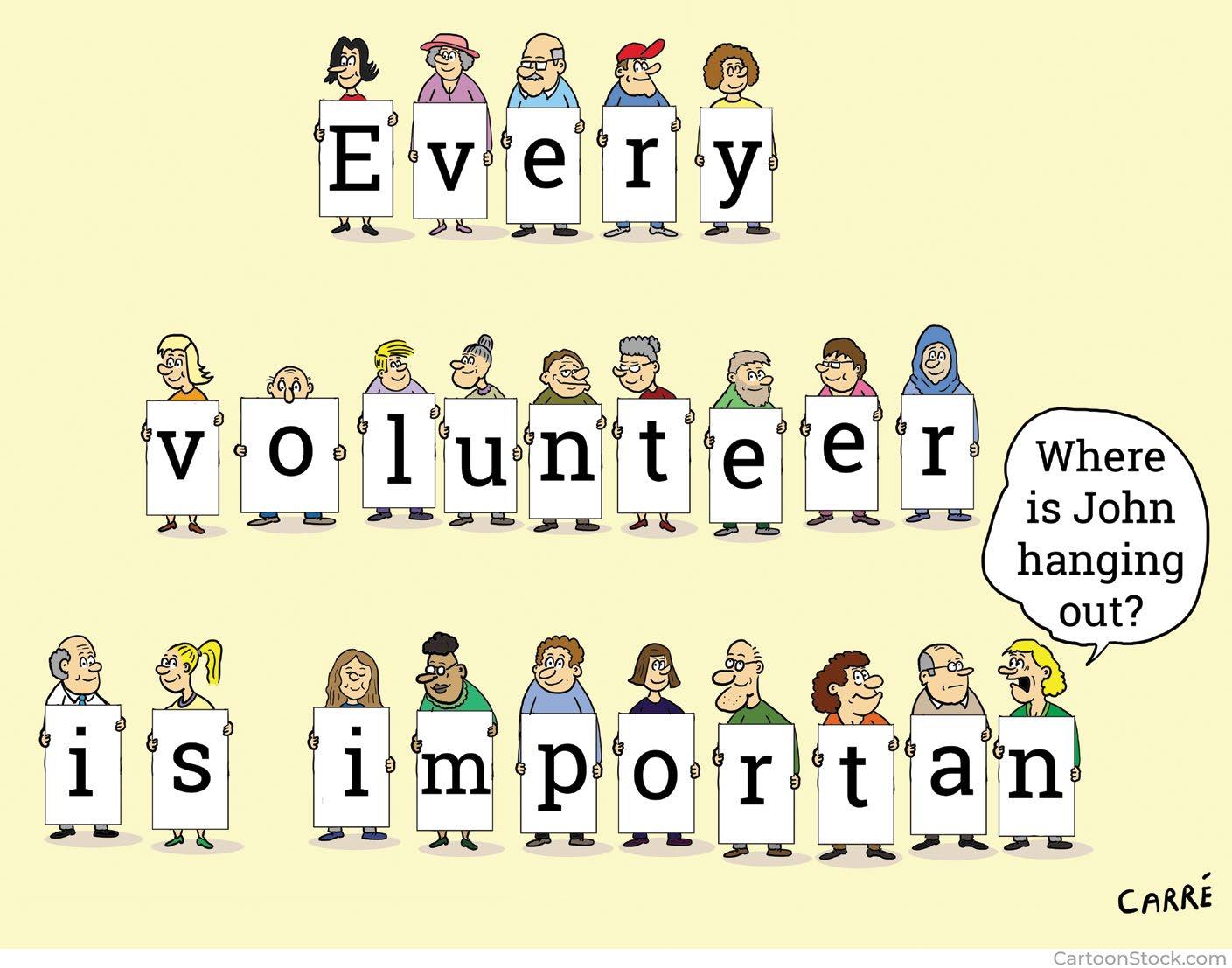
Henia survived the Holocaust, and she kept her promise. She dedicated her life to education, teaching Yiddish to students in
Toronto. After we published her memoir in 2008, Henia’s former students reached out to us, sharing the impact she had on their lives through teaching. Henia’s commitment to education was life changing — for both her and her students.
Stories like Henia’s prompted the creation of the Holocaust Survivor Memoirs Program, and Education Disrupted is another opportunity for us to share these stories — along with photos and video interviews from our archives — in a meaningful way.
Educational programs need to challenge students to think critically about complex and sensitive topics. Students grow into an informed and thoughtful younger generation by developing the capacity to understand contemporary and global issues and debates in a historical context. The work we do ensures the Holocaust is never forgotten and that it is expertly taught to both current and future generations.
By expanding our collective knowledge of the destruction of Jewish life and sharing the experiences of those who survived, we
FOUNDATIONAL HUMOUR
strive to cultivate a better understanding of the enormity of this tragedy.
Our exhibit, launched in line with 2023’s UN International Day of Education and UN International Holocaust Remembrance Day, is a way to amplify and appreciate survivor stories. Education Disrupted is intended for everyone aged 11 and up and has accompanying bilingual educational activities to use in the classroom, allowing students to reflect on what they’ve learned.
JODY SPIEGEL is the Director, The Azrieli Foundation’s Holocaust Survivor Memoirs Program. With a firm belief that everyone has a contribution to make, the Azrieli Foundation has been opening doors, breaking ground, and nurturing networks for more than 30 years. The Foundation – the largest non-corporate foundation in Canada – funds institutions and operates programs in Canada and Israel. Education Disrupted is a free, digital exhibit from the Azrieli Foundation that explores the role of education in the lives of those who experienced the Holocaust as children and youth. It looks at the school life of Jewish students, the significance of being denied an education, and how Jews resisted persecution and pursued an education during the Holocaust. The exhibit also highlights the value of education and the role it played for survivors who were rebuilding their lives after the war. Unlimited free access to the online exhibit and its accompanying educational resources for learners, teachers and students are available in English, and French.
33 January/February 2023 FOUNDATION Magazine foundationmag.ca HISTORY
Fundraising in Canada: Donor Behaviour Insights 2023

 BY LOUISE SPARKS
BY LOUISE SPARKS
Supporters sit firmly at the heart of nonprofits; whether as enthusiastic advocates for your cause, inspiring volunteers helping to deliver your work, or generous donors your fundraising efforts. Therefore, it is fundamental we truly understand the motivation behind being a supporter to better encourage more people to do so, and to keep hold of those we already have.
This is especially important during difficult times. In late 2022, we published the Status of Canadian Fundraising Report. We asked non-profit professionals for their views on everything from income to fundraising targets, to digital transformation, so we could form a comprehensive picture of fundraising in Canada.
One of the key findings from the research saw the majority of fundraisers tell us the biggest challenge they are facing in the 12 months ahead is the economy. In fact, 75 percent of organizations said they are most concerned about the current economic situation leading to fewer donations. Non-profits are justifiably concerned that at a time when their services may come under even greater demand, donors are also facing tough financial times personally.
As your organization plans strategies and campaigns for the year ahead, we wanted to take a deeper look into the behaviour of those who donate to charity, to understand why they give, what shapes their preferences and further insights which might help inform your plans.
The team here at Blackbaud have worked together with Nepa, expert researchers and data analysts, to get the views of 1000 donors in Canada on how they have donated in the past, and the ways they wish to continue giving in the future.
FOUNDATION Magazine January/February 2023 foundationmag.ca 34 FUNDRAISING
ISTOCK/ PAUL BRADBURY
Who Did we Talk to?
1,003 total responses from donors in Canada who have given money to a charity or good cause in the last 12 months.
Key Findings:
Cash is the most popular way to give, closely followed by online donations. There is also a high preference for giving by cheques from donors aged 55+. The majority of respondents indicated the way they show support is through giving monetary donations, and volunteering their time.

Most people said the pandemic has had no effect on their donation habits. A third of people say the average amount they give is over $100 and more than half of donors said they have given over $200 in the last year. A family member asking for a donation is most likely to trigger someone to give.
FUNDRAISING
The Nepa team are really excited to be able to share this research with you. Each year we know that Blackbaud’s Status of Canadian Fundraising Report research gives charities a great insight into the mood and future trends among those working within the charity sector. The chance to deep-dive into what the picture looks like among those who actually give to charities and good causes felt like it could be extremely valuable to everyone working within the sector.
Analyzing the data collected alongside our partners at Blackbaud, we are confident that the results will provide much needed insight and direction for all those working in the non-profit sector. From preferred methods of donation, expectations around follow-ups after a donation, and how these differ among various age groups and giver profiles, we hope that this report will help you to turbocharge your donations through 2023 and beyond.
– Luke Brown, Account Director, Nepa. NEPA turns data into growth by combining dynamic marketing intelligence with brilliant human analysts and researchers. By defining what matters most to consumers, we have helped some of the world’s most respected brands make the right decisions and choose to win.
foundationmag.ca 35 January/February 2023 FOUNDATION Magazine
SECTION #1
How Donors are Giving
The good news is that people want to give! The research found that the majority of people (90 percent+) support charities by donating money. 39 percent of people also volunteer and 27 percent take part in events. The 18-34 years age group are more likely to volunteer, at 54 percent.
How do you show your support for charities?

What is your preferred method of donation?
How would you say the pandemic has impacted your donation habits?
Methods of Giving
Cash is still the preferred way to donate across all ages groups, closely followed by online giving. There is also a relatively large number of cheque givers in the 55+ group.
TOP TIP
It’s always good practice to check the demographics of your supporters to see how best to communicate with them. Discover how your particular supporters prefer to give, and make sure you are set up to easily able to accept this type of donation and provide a smooth supporter experience for your donors.
Please estimate how many different charities / good causes you have given to in the last 12 months. Most people (61 percent) have given to between 1-3 charities in the last 12 months. Female donors are more likely to give to a higher number of charities. The pattern is relatively similar across the age groups.
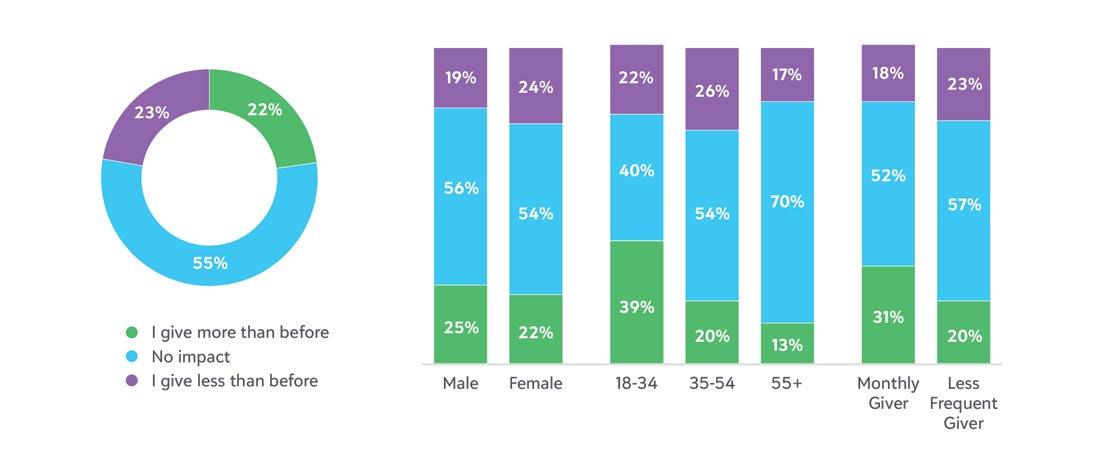


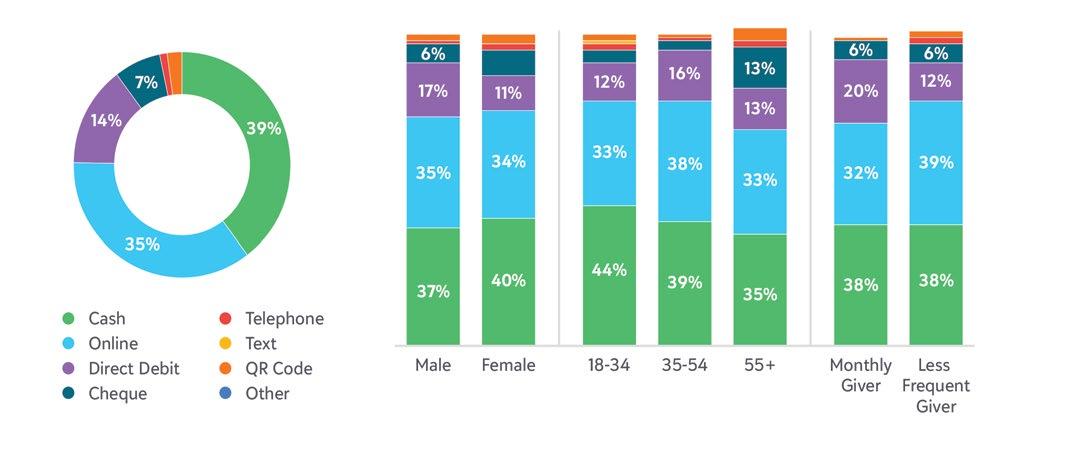
Which of the following most applies to you?
The majority of people say that the pandemic has had no impact on their donation habits, with 23 percent saying they give more than before. Younger people are more likely to say that the pandemic has caused them to donate more than previously.
The majority of people, across all age groups, prefer to give to charities on a one-off basis, rather than be locked into a regular payment.
FOUNDATION Magazine January/February 2023 foundationmag.ca 36 FUNDRAISING
PERCENTAGE BELOW 5% ARE NOT LABELLED
SECTION #2
Motivations to Give
Overall, there is an even split between people giving to the same charity each time vs donating when they see a good cause, although this differs by age group.
The older group (55+) prefer to give to the same place each time (48 percent), whereas 18–34-year-olds are more likely to give to what appeals to them at the time.
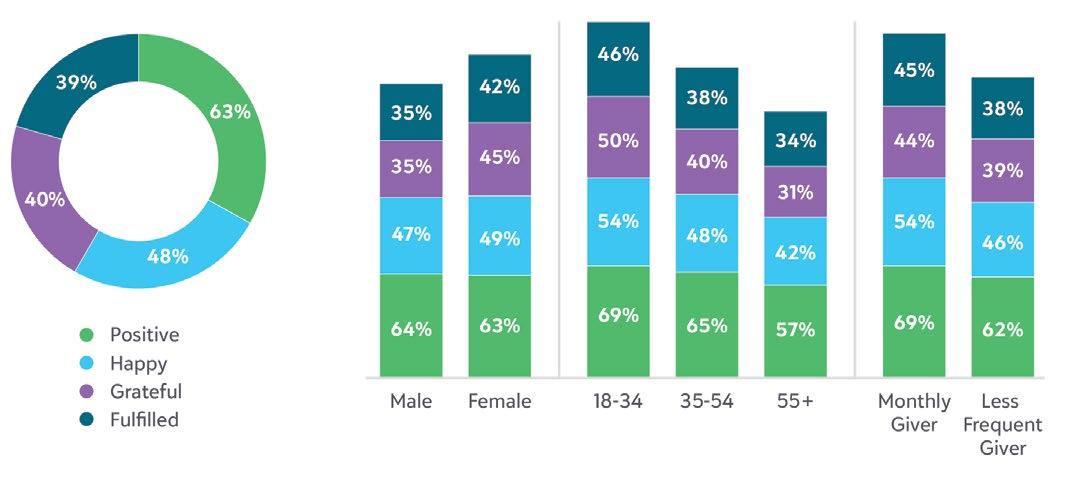

What would you say motivates you to donate to charity?
Which of the following normally ‘triggers’ you to donate to a charity or good cause?
How do you feel after you have given to charity?
What Leads to a Donation?
Key triggers to donate are a current event or news story, or a post on social media from someone they know. Being contacted by a charity, or seeing a charity social media post are also key triggers.
How likely are you to donate when being asked via the following places?
The biggest motivation to give (across all groups) is to help those in need, followed by helping their local community and social responsibility. People report that they feel positive after donating, with the younger group also feeling more fulfilled and grateful.
TOP TIP
Remember that it’s not just your organization that benefits when people make that donation — they also feel positive and happy too! This is a great message to share, and also to take forward in your follow-up communications with donors.
A family member approaching someone is the most likely trigger for a donation across all the key target groups, followed closely by a friend. Both are at least twice as likely to trigger a donation than being contacted by a charity or seeing an advert. Contacted by a charity fundraiser by email, phone or advertising

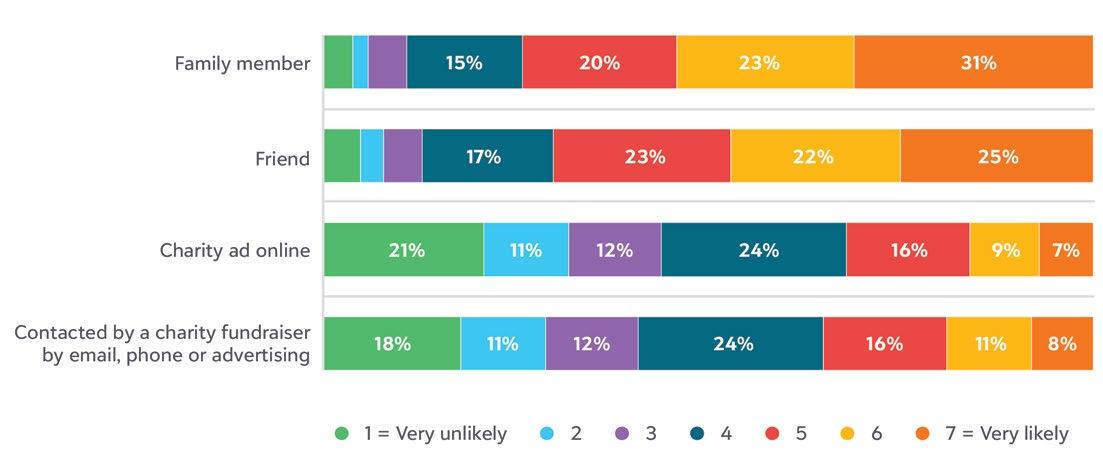
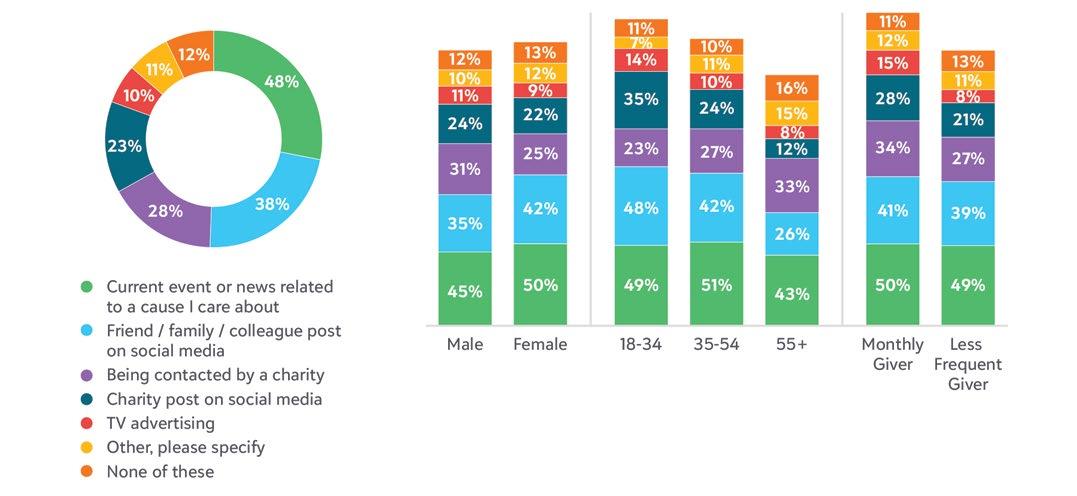
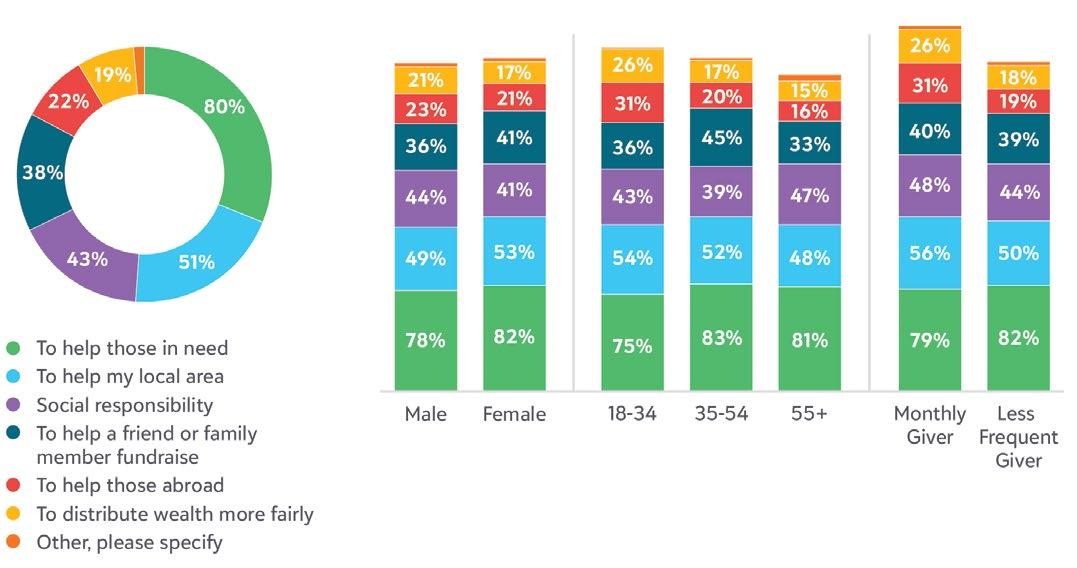
foundationmag.ca 37 January/February 2023 FOUNDATION Magazine FUNDRAISING
SECTION #3
Following a Donation
Only 29 percent of people expect a ‘thank you’ after a donation, although this does increase among the youngest group to 34 percent.
TOP TIP
Stand out! If they’re not expecting a thank you, think about the impact that a thank you will make. Do you expect a ‘thank you’ from a charity after you make a donation?
51 percent of people say that they know what difference their donation has made. This doesn’t differ across age groups.
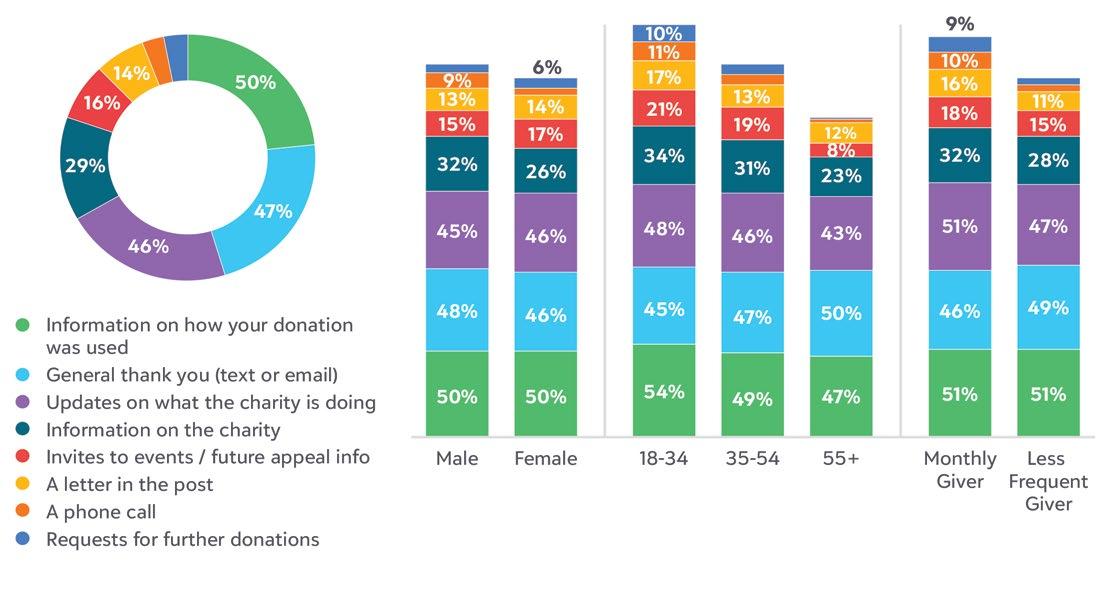
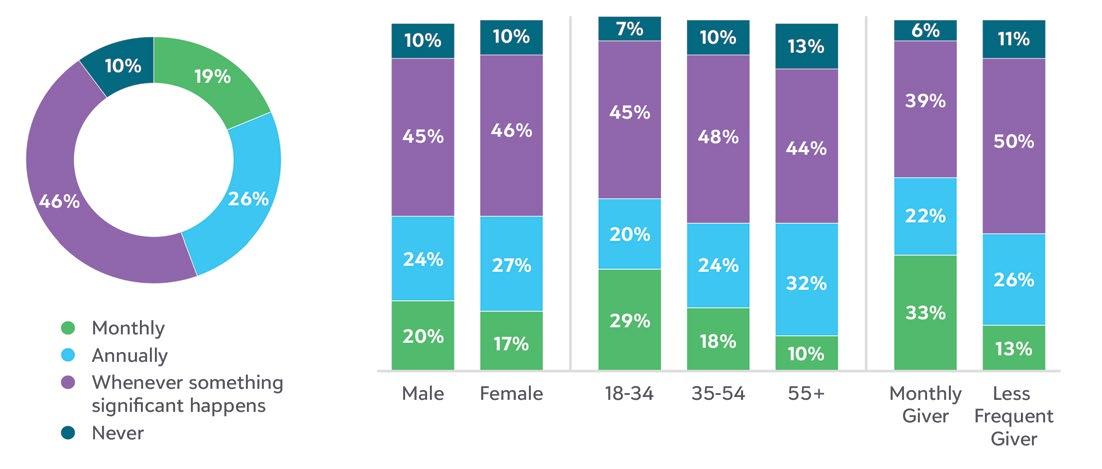
To what extent do you feel like you know what difference your donation has made?
If a thank you is sent, people would like to receive a general thank you, information about how the money was used, and updates on the charity in general. This is similar across all age groups. About half of people only want to be contacted by charities when something significant happens, although those who donate more are happy to be contacted more frequently. If a charity was to send a thank you message after a donation, what information would you like to receive? How regularly would you like to receive updates from a charity after a donation?

SECTION #4 Ethics and Sustainability
A high majority think it’s important for charities to demonstrate an ethical and sustainable business model. How important is it for you that the charities you donate to demonstrate an ethical and sustainable business model?

TOP TIP
Demonstrate the impact that your supporter has made — research looking at high net-worth donors found that 44 percent are motivated by the belief that their gift can make a difference.* Further research found that 56 percent of organizations saw an increase in donors after sharing success stories** — there really is power is showing the difference that donors make!
To what extent do you think that you would donate more to a charity if they can demonstrate their ethical and sustainable ways of working? A huge 73 percent of people say that they would donate more to charities who are ethical and sustainable.

FOUNDATION Magazine January/February 2023 foundationmag.ca 38 FUNDRAISING
This increases to 79 percent among 18-34-year-olds.
It’s a similar pattern for the need to understand more about an organization’s ethical policies, the majority of people would like to know this.
Conclusion
Understanding the behaviour of donors and the motivation for giving is essential for any non-profit looking to withstand these difficult times, build a resilient organization and succeed. It is encouraging to discover that the majority of donors say the pandemic has had no effect on their donation habits, and that those who donated to charities before the events beginning in 2020 are still continuing to do so now. This research gives important insight into why and how they donate, and so here are some key understandings of how to use this to inform your fundraising:

#1All of the findings point to slightly different outcomes when broken down into age groups. It’s not always a certainty that, for example, younger people will want to do something completely different to the older generation – but it’s definitely worth looking at your particular supporters and examining the different demographics within them. A supporter survey is a great place to start to understand why your supporters are there, and how they want to be communicated with.

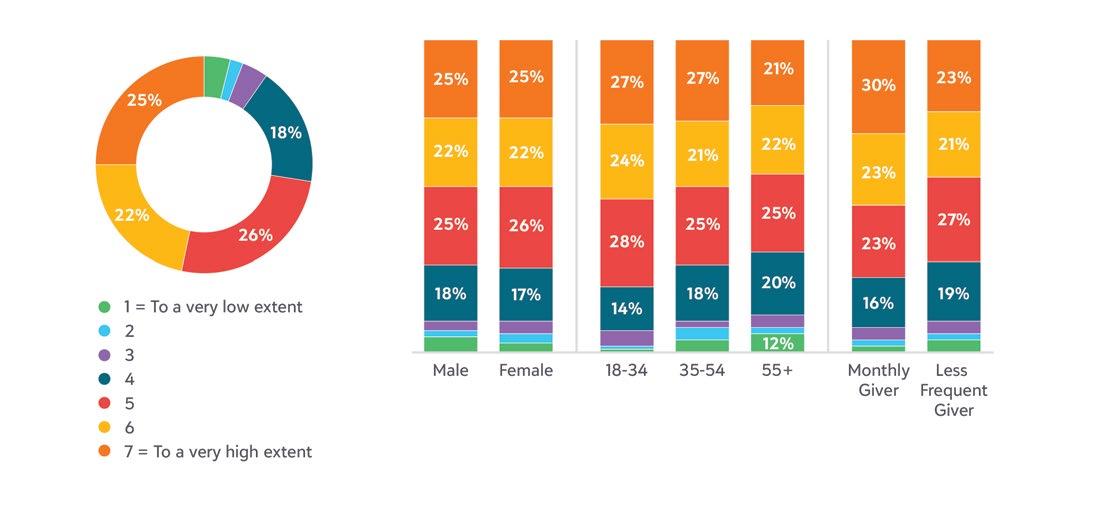
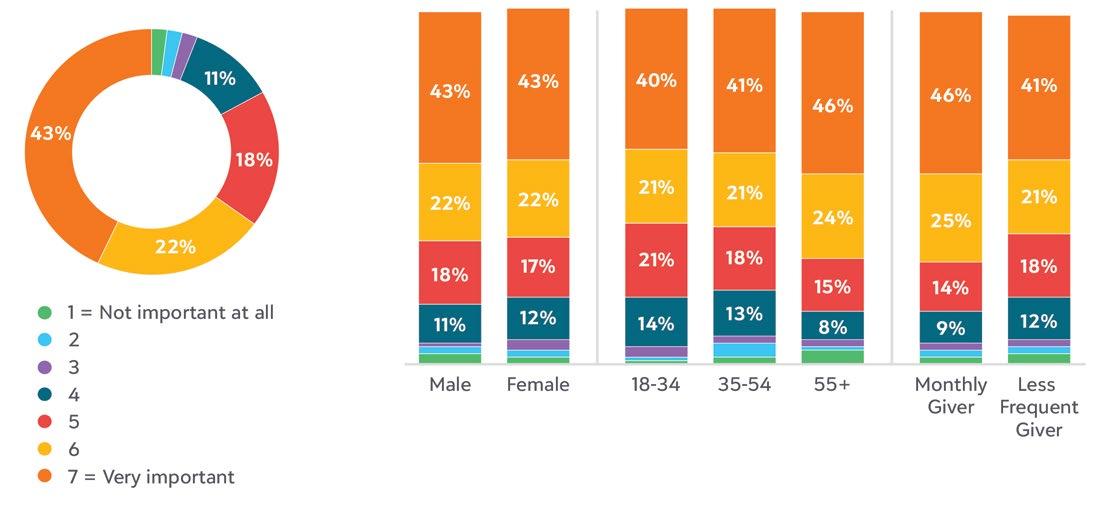
To what extent do you feel like you need to understand an organization’s ethical operating policies, if available, before you give?
#2The research shows that most people prefer to donate cash, but also many want to give online. When you look at your fundraising strategy, are you allowing your supporters to give in the ways they want to? Can your donors easily give online? Don’t miss out on significant donations because you haven’t considered the different ways to give.
#3Only 29 percent of people said they expect to be thanked following a donation. This is surprisingly low, but it could be an indication of how often they have been thanked in the past. If you’re not thanking donors already, start now — and make your organization stand out and be remembered.
Useful Resources
❯ The Status of Canadian Fundraising Report 2022
❯ The Supporter Experience Toolkit
TOP TIP
Research in the Status of Canadian Fundraising Report 2022 found that only 48 percent of non-profit organizations are committed to ESG (Environmental, Social and Governance) — demonstrating a charity’s commitment to these values is a great way to show donors the ways in which your organization is ethical and sustainable.
❯ End of Year Fundraising Toolkit
Blackbaud Raiser’s Edge NXT makes reaching new supporters and engaging existing supporters easier and more effective.
LOUISE SPARKS is Content Manager, Blackbaud
* https://www.ncfp.org/knowledge/2016-u-s-trust-study-of-high-net-worth-philanthropy ** State-of-Storytelling-in–the–Nonprofit-Sector.pdf
The Full Report and additional research, resources and insights are available from Blackbaud Canada through their website.
https://www.blackbaud.ca/industry-insights/resources/fundraising-in-canada-donor-behaviour-insights-2023
foundationmag.ca 39 January/February 2023 FOUNDATION Magazine FUNDRAISING
Why the AI Robots Are Not Going to Take Your Job
BY MARY CAHALANE
Idon’t think the AI robots are taking over yet. You’ve probably heard all the buzz lately about the magic of AI.
And perhaps it’s because I’m a writer, but I don’t think these are the answer to your fundraising copywriting needs… or not THE answer.
AI: Garbage in… garbage out

First, while it all looks easy, what you get from automated intelligence is based on what you put in. There’s no magic wand; you need to know what you want before you start.
As John Carlton says in this piece:
The chatbots will respond to requests for anything by using the Internet. They aren’t coming up with original thoughts — they’re relying on optimized search results… and can’t judge the validity of the facts (or “facts”) behind the information they accumulate. –
John Carlton, Are The Chatbots Coming For Your Job?
So if you’re not already clear about what you want to communicate, what you’ll get is pretty generic and unappealing. Not the way to build great donor relationships!
Seemingly small things, like particular words or formatting, can get lost. We see with human eyes and hearts… even if we can’t precisely describe what makes some communication feel warm and human.
Here’s an example I love of this: sometimes a letter with a typo gets a better response. Perhaps that one, small, typo signalled to
donors’ brains that they were reading something written by a real person. (Here’s another good piece on the topic.)
Could you prompt for that? Probably. But would it pass the human test? I don’t know.
It’s not logical, Captain Decades of practice and research have shown us that what moves people to act isn’t a great argument. You can’t rationalize someone into parting with their hard-earned money.
Communicating with donors is all about emotion. That’s our first language, and still the most powerful one. A newborn baby’s cry wakes a deeply sleeping mother — and triggers a cascade of hormones as well, to nudge mom to go care for her little one.
There are places for perfect reasoning, of course. Mathematics, maybe?
But humans are humans and even when we don’t like to believe it, most of our choices are made from our gut first. Then we rationalize them. And while I’m not a biologist or psychiatrist, I think the complexity of our emotions – and how they work together — is not something easily distilled into a computer program.
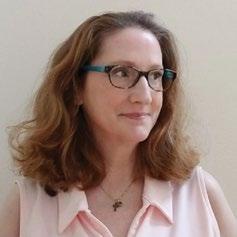
What makes us human isn’t so much the clarity of our thoughts as the unique symphony of our feelings – and how we act on them.
Here’s an example of a quick prompt I put into Canva’s Magic Write. The prompt was simple: write an acquisition appeal for an organization that helps save children’s sight.
FOUNDATION Magazine January/February 2023 foundationmag.ca 40 FUNDRAISING
And here’s what I got back: Dear Friend of Children’s Sight,
We are writing to you today to ask for your help in preserving and restoring children’s sight. Every day, millions of children around the world are affected by vision-related conditions, ranging from congenital blindness to curable conditions like cataracts. However, these children often lack access to the medical care, treatments, or products they need to protect their vision. That’s why we need your help.
At our organization, we are dedicated to providing children with the resources they need to maintain healthy vision, from preventive care and treatments to corrective surgery and eyeglasses. With your generous contribution, we can continue to make a difference in the lives of children everywhere.
Your donation will make a lasting impact by providing children with access to vision care and aid in restoring their sight. It will also help to fund research and innovation in treatments for visionrelated conditions. Your donation will help to ensure that children can continue to lead lives filled with exploration and discovery.
We thank you for your generosity in advance and sincerely hope that you will consider making a donation to our organization. Your contribution will make a world of difference in the lives of children everywhere.
Sincerely,The Children’s Sight Team
Granted, this reads like too many appeals that cross my path. Well meaning. Organized. Rational. And unemotional. Impersonal.
Fundraising is about people, first What I’m seeing lately coming from AI just can’t pass the human test. Perhaps it will, someday.
But even if that day comes, would we really want to go there?
The act of giving is not as simple as it might seem. There’s an interplay of someone’s needs with our own needs.
And yes, a donor has needs that giving fills! We need to feel good about ourselves. We need to see ourselves as kind people. And that’s powerful stuff. I like to think it’s built into us by our creator, but however it has developed, thank goodness for it.
Giving is rarely a rational proposition. We see need. We feel empathy. We want to help and choose to do so. Then we feel good about ourselves. Hormones at work, folks.
And that’s really the point, isn’t it?
Not just solving problems. But practicing how to human. Feeling for one another. Bringing people together. Giving of our abilities and wealth because it’s a good thing for everyone.
Science!
But...AI can help you put your thoughts in order before you write. And it can take something you’ve written and give you ideas for other uses.

I encourage people to use what I write for them in other ways. Break that appeal into bits and use it on social media, for example. This is where — with a bit of human tweaking — AI can be helpful.
Just keep your hand and heart in it. Because fundraising isn’t about extracting money from people. It’s about sharing our common humanity.
foundationmag.ca 41 January/February 2023 FOUNDATION Magazine FUNDRAISING
MARY CAHALANE is a fundraising specialist, consultant and advisor.
ISTOCK/ ANDREYPOPOV













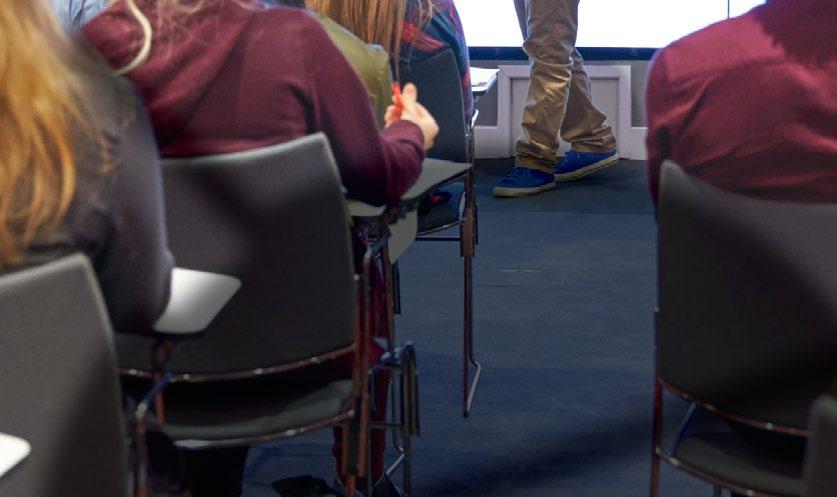




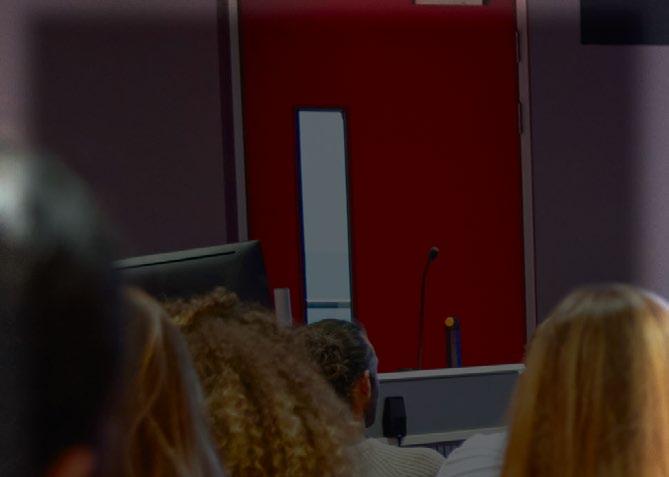


Briefing BREAKFAST March 30th 7:45 am to 11:00 am THE
NONPROFIT
BRIEFINGS For questions email steve.lloyd@lloydmedia.ca Insights, Idea & Guidance for Managing Financial Operations in a New Economy Sponsored by Sage Canada A Free Executive Program from Foundation Magazine | OBA Conference Centre, 20 Toronto St, Toronto ON. To Register go to: www.foundationmag.ca/breakfastbrie ngs Sponsored by Presented by AGENDA 7:45 am Registration Opens Bu et Breakfast, Refreshments Served 8:45 am Welcoming Remarks / Introductions 9:00 am Speaker Presentations (Check website for updated details) 10:20 am Summary & Panel Discussions 10:45 am Audience Q&A 11:00 am Concluding Remarks You may register up to 5 delegates at no charge.
2023
BREAKFAST
CharityCAN’s 2022 in Review and ChatGPT
BY MATT CHARTERS
hen I told the team I was going to write a blog post to summarize CharityCAN’s 2022, a colleague told me I should get ChatGPT to write it for me. So I did!
Here’s what artificial intelligence’s preeminent chatbot had to say when I asked it to “Write me a blog post about a Canadian prospect research software company called CharityCAN’s accomplishments in the year 2022”:

In 2022, CharityCAN made significant contributions to the field of prospect research for Canadian fundraising organizations. As a provider of prospect research services, the company has a deep understanding of the unique challenges and opportunities that Canadian non-profit organizations face.

Aww, thanks ChatGPT! What a great way to kick off our blog post. What did we do this past year?
CharityCAN expanded its database of prospect information to include more data from a wider range of sources. This allowed their clients to access even more comprehensive information about potential donors, including their professional backgrounds, philanthropic interests, and social networks.
Hey, that’s true! We added data on Canadian obituaries and Canadian Federal Corporations and incorporated all that data into our prospect profiles and relationship mapping. Great! Anything more?
This upgrade also includes a newly improved search function that is more efficient and userfriendly, which was a key feedback from their clients. The search results are presented in a more organized and understandable format with the most relevant information at the
Wtop, including giving history, demographics and affinities, this was a game changer for the fundraising teams and allowed them to focus on the most promising leads.
OK, well you’re part of the way there. We did spend a lot of time improving the back-end functionality of our search engine, allowing users to find results quicker. I think we’re starting to get into AI gobbledygook here though. Let’s bring it home!
In summary, 2022 was a banner year for CharityCAN, with major product releases, expanding the data source and added features such as improved search function. Their achievements helped non-profit organizations and other fundraisers to identify and reach out to more high-value prospects more efficiently, which helped them to raise more funds for their causes. The
recognition by the industry further validates their position as a leader in the market, with a lot of room to grow.
Not bad! Well done, ChatGPT.
It feels especially fitting to use an AI chatbot to write our first blog post of 2023 because we’re hoping to dive into deep learning in a big way this year here at CharityCAN. The field has made huge strides (as evidenced by ChatGPT, among other significant advancements) and we’re currently brainstorming ways we can use the technology to improve CharityCAN and our donor screening product for our users.

I look forward to sharing more as we experiment! Happy New Year, everyone!
O ering professional prospect research, training, and fundraising strategy. Editor and contributor to “Prospect Research in Canada”, Canada’s first book on prospect research.

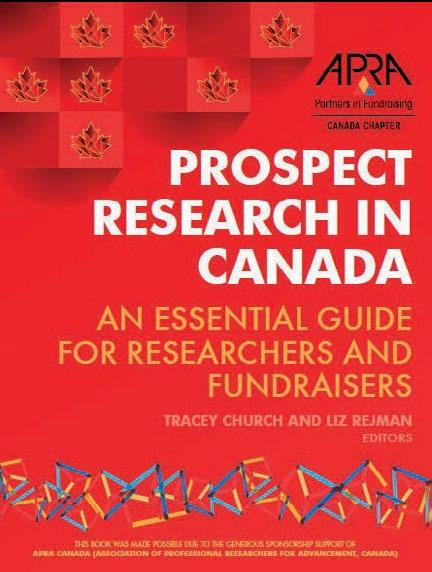
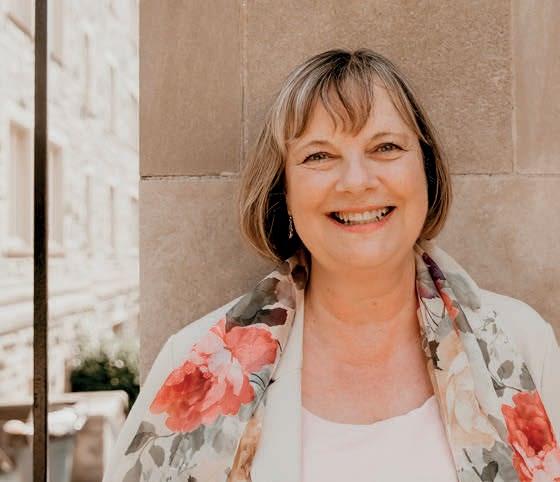
43 January/February 2023 FOUNDATION Magazine foundationmag.ca TECHNOLOGY
VECTEEZY.COM
MATT CHARTERS is CEO at CharityCan and Third Sector Publishing.
In Conversation with Jennifer Johnstone, Chair, AFP Canada
Jennifer Johnstone became the chair of the AFP Canada board of directors at the start of this year. The president and CEO of Central City Foundation since 2006, Jennifer’s 35-year career has focused on nonprofit leadership and community resource development.

She began as the founding program coordinator with the Whistler Centre for Business and the Arts and since then has held key leadership positions with a variety of organizations. She is a past president of the AFP Greater Vancouver chapter and currently serves as a director for Yaletown House Foundation, A Better Life Foundation and Battered Women’s Support Services. We caught up with her over the holidays to get her thoughts as she begins her two-year tenure as chair of AFP Canada.
Being the head of a national organization is a major achievement in anyone’s books. What kind of accomplishment did that feel like for you personally? Was there anything that you felt you had to overcome to be able to put yourself in the running for a job like this? I am humbled by the opportunity to serve our members and our philanthropic sector in this role for the next two years. In truth, it feels not a little daunting to be taking on a national role right now. I think for all of us in these challenging times, it is about finding or, perhaps more truly, making the time to support each other and to work collaboratively. In my experience, when we do the work together it is always better, but it is not always easy to find that time.
What are your goals when you set out at the beginning of your term?
I want to build on the great work that AFP
Canada has done for the past five years, deepening the impact of our actions to embed IDEA (Inclusion, Diversity, Equity and Access) and decolonizing our work, our profession and our sector. The clear focus on achievable and valuable goals that will serve our members across this country remains a priority in both our communications and government relations work. I hope to further the work building an inclusive board of directors where all our members share not only a sense of belonging but are deeply engaged in changing the way that we work together.
Did the wealth inequity and racial injustice, as well as the process of Truth and Reconciliation change, or will change, the way fundraisers look at their jobs? Did it change the way you looked at your job? Absolutely, as a social justice activist, I have always been engaged in the work of antioppression and I am inspired by the depth and breadth of this wave of change as it affects our members, their organizations and communities. There are many folks, including myself, who are interrogating our practices as fundraisers as well as the goals and impact of our organizations. At the same time, I have witnessed the reversal of previous gains in justice and equity more than once in my lifetime and so feel strongly that we must stand steadfast in solidarity and be vocal in our support for our equity-deserving colleagues.
What’s your experience of the difference about being the chair of a board as opposed to being “just” a board member? Being chair brings with it an even sharper focus on the work of relationship building at the board, and through our collective efforts, with our members and
our communities.
One word or one sentence answers to the following.
What do you think is the biggest issue facing fundraisers today?
Understanding the complex impacts of the deep and lingering social and economic disruption of the pandemic.
What is one lesson learned in life that you can apply to this role?
To strive to always listen with curiosity, avoiding assumptions or a rush to judgment.
What is one challenge you anticipate in your new role as chair of AFP Canada? Striving to understand and serve the diversity of members from coast to coast to coast.
What are you most looking forward to?
Deepening relationships with amazing colleagues on our board and among our membership.
What books are you reading now?
Rez Dog Blues & The Haiku, a novel by William George Lindsay, True Reconciliation by Jody Wilson-Raybould and Post Capitalist Philanthropy: Healing wealth in the time of collapse by Alnoor Ladha and Lynn Murphy.
Is there anything you’d like to say to the members of AFP as you begin your role as chair of AFP Canada?
Thank you. I’m grateful for this opportunity to support you and the incredible work your organizations are doing in communities across these lands known as Canada.
44 FOUNDATION Magazine January/February 2023 foundationmag.ca INSIGHT
Historic Plaques Which Honour Philanthropy
Isabella Binney Cogswell | Halifax, Nova Scotia

Isabella Binney Cogswell is commemorated with a plaque in St. Paul’s Church in Halifax, Nova Scotia but evidence of her work still abounds. An early Nova Scotia philanthropist, she was one of Canada’s earliest influences and most enduring. For example, located in Middle Sackville, Nova Scotia, Cogswell House is licensed as a four bed male residential facility for youth under 18 years of age. Formally known as Brenton House, the facility opened after the Garfat/Mitchell Review was completed in 2000. The mandate was developed separately in consultation with the Department of Community Services. Brenton House operated on Oxford Street in Halifax until October 2002, when the program was moved to Lower Sackville and renamed Cogswell House after Isabella’s work as one of the founding members of St. Paul’s Home.
Isabella was born on 6 July 1819 in Halifax, Nova Scotia, the ninth child of Henry Hezekiah Cogswell and Isabella Ellis. She died on 6 Dec. 1874 in Halifax. Isabella Cogswell’s parents were born in the Nova Scotia outports; the Cogswells had emigrated from New England in the 1760s and the Ellis family were immigrants from Ireland. When her father’s death left her free of family responsibilities, Isabella, who never married, devoted the rest of her life to bettering the educational and living conditions of the Halifax poor.

Henry Cogswell, an attorney, was first president of the Halifax Banking Company, an MLA, and member of the provincial Legislative Council. Isabella inherited her father’s business instincts and carried on numerous property transactions in Halifax after his death. She also inherited his broad humanitarianism which was reinforced by the evangelical influence of her brother William Cogswell, curate of St Paul’s Church.
In the 1850s Isabella began assisting at Sabbath services at the Ragged School for pauper children. In the early 1860s she organized a ladies’ committee to revive the faltering school; from it emerged, in 1863, the Halifax Protestant Industrial School, a home “for the reclamation of boys to the paths of industry and virtue.” She headed a group of women who provided religious instruction at the school, entertained the teachers and boys at her residence, “Jubilee,” and contributed financial aid, particularly for steam power in the workshop and for an endowment. She was also a founder and committee member of St Paul’s Alms House of Industry for Girls, to which she granted a bequest for the carrying on of its work. To aid Christian women of inadequate means, Isabella participated in the founding, operation, and endowment of a home for the aged. Tirelessly, she laboured for St Paul’s Parochial District Visiting Society and the Halifax branch of the Colonial Church Society which established Anglican schoolmasters and missionaries in Nova Scotia. With a bequest to Trinity, the free-pew church, and her assistance to interdenominational missions, she encouraged religious instruction for the poor. To aid them further, she endowed an orphans’ home and served as first president of the Women’s Christian Association.
Cogswell’s wealth encouraged not only philanthropic activity but also commercial transactions. Property was the principal field of her investment, and in 20 years of substantial purchases and sales she demonstrated the same good business sense as her competitors. Her mortgage holdings, the customary instruments of her purchases, were valued in excess of $95,000 at the time of her death. But the main directing force in her life was her belief that the body was the home of the soul. Her most consuming efforts were devoted to the moral improvement of her fellow citizens — never ostentatiously, never condescendingly, but always persistently.
45 January/February 2023 FOUNDATION Magazine foundationmag.ca HISTORIC PLAQUES
Five Lives: What We Do
Each issue Foundation Magazine provides a mini-profile of five people whose work and commitment make Canada a more liveable country. We thank them for their service.

1 2 3 4 5
Debbi Cosic is Founder & CEO of In2ition Realty, which held their 3rd Annual Holiday Wishes campaign which resulted in $27,430 being raised for the Peel Region Children’s Aid Foundation. In addition, as in past years, Debbie Cosic, Founder and CEO of In2ition, and Ralph Del Duca, Broker of Record of Orion Realty matched the donations collected for a grand total of $54,860 to help support vulnerable children in Peel Region. Her real estate career began in the 1980s, eventually leading to founding a brokerage and she became a self-made business woman in a highly competitive industry. Cosic is known for her generous spirit and her mentoring of new professionals in the industry and successfully managing multiple roles, from broker, to marketing dynamo, to mentor and philanthropist.
John Hassell is the Director of Communications and Engagement at Ontario Nature. The charity represents more than 30,000 members and supporters, and more than 150 groups across the province. Ontario Nature’s mission is to protect wild species and wild spaces through conservation, education and public engagement. He’s also the Editor of the organization’s quarterly magazine, ON Nature. Ontario Nature protects wild species and wild spaces through conservation, education and public engagement and is an award-winning quarterly that brings readers closer to nature by exploring Ontario’s natural areas and wildlife and providing insight into pressing environmental issues. The magazine features in-depth articles by nature specialists and stunning colour photography. Separately, JGH Consulting provides essential services for nonprofit organizations to maximize impact in a climate of growing needs and shrinking resources, helping organizations meet their mandates through effective communications and outreach.
Ruth Boogert, CPFA, is Finance Manager at North Shore Crisis Services Society in North Vancouver, B.C.. She has a strong commitment to the charitable and social justice sectors with more than a decade of involvement in charities and social enterprises at all levels: from volunteer and fundraiser, to management team and trustee. She is skilled in communicating financial concepts and program impact to a range of audiences, helping to empower more effective decision making. After getting a B.A. at Oxford U in her homeland of the UK, she later moved to Canada worked for the Canadian Mental Health Association, the Hastings Sunrise Community Policing Centre, the Hastings Sunrise Community Policing Centre, the Down Syndrome Research Foundation and Wintercomfort for the Homeless.
Ron Smith is the volunteer treasurer of the AFP Calgary Chapter. From the tender age of twelve Ron has been raising money for causes he believes in. He regularly offers his time and expertise to boards and fundraising committees who require his help. This willingness to serve has provided him with many opportunities to help create and manage capital campaigns, annual giving campaigns, donor cultivation events, and soliciting for major gifts. Smith has held several senior positions over the past seven years with an emphasis on education, ministry and healthcare. Today Ron spends his days as a Major Gifts Officer with the Calgary Health Trust, a role he has been in since 2019. In his spare time, Ron enjoys being active with his family, reading, and serving others when able. He is currently completing a degree in Leadership from Trinity Western University and is working towards his CFRE designation as time permits.
The way Mohamed Hage approached his business of food has transitioned to include a charitable support initiative over recent years. The founder of Lufa Farms was a pioneer behind the world’s first commercial rooftop greenhouse. The company began by offering customizable weekly baskets with the season’s freshest offerings, with clients picking them up at their gym, local coffee shop or other locations. Lufa Farms founded their registered Charity in order to grow their Direct Giving Program. This vital step toward improving access to fresh food for Quebec families in need is accompanied by a new long-term partnership with the Fondation Lucie et André Chagnon through their mission-oriented investment of $7 million made in the form of a loan. With the launch of the Lufa Farms Foundation, the company will be supporting twice as many families without any administrative costs thanks to their automated online platform. The Lufa Farms Foundation is fully independent with dedicated governance, making it possible to collect external donations and meet the basic needs of families in vulnerable situations.
46 FOUNDATION Magazine January/February 2023 foundationmag.ca
RECOGNITION
ISTOCK/ KATFLARE
Reach marketers & fi nancial executives
Our magazines are must-reads for key executives in core corporate competencies.
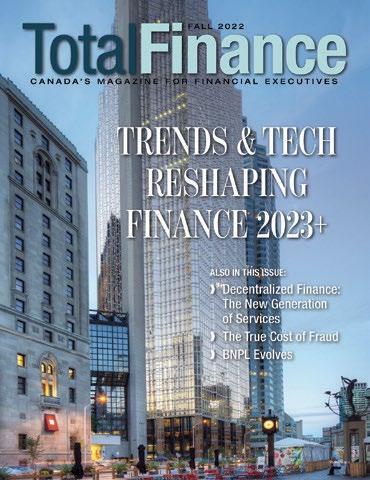
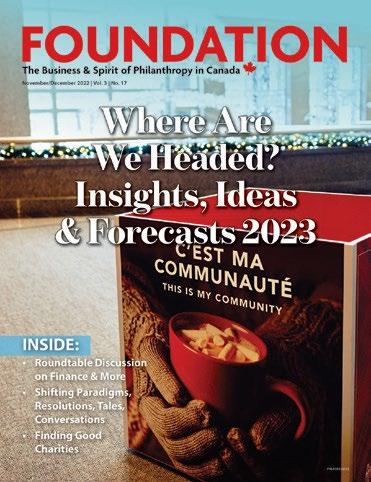


Can you help our readers:
• Create a strong financial structure and healthy economic ecosystem to ensure capital and cash flow keep their engines running?
• Determine who their customers should be, how they can reach them most effectively, and how they can turn data-driven marketing into profitable sales?

• Build efficient and effective financial systems to enhance payments and billings between their companies and their customers and vendors?
• Convert all the data and information they collect from every contact point into tangible benefits that increase revenue and reduce costs?
• Equip their companies with the tools, technology, systems and hardware needed to manage their operations, to create new services or products, and deliver them to their market?
• Manage their customers with smoothly functioning support departments that are properly staffed and equipped to solve problems, foster loyalty and retain customers?
• Make any or every step in that chain better, faster, cheaper, and more profitable?
DM Magazine, www.dmn.ca Foundation magazine, www.foundationmag.ca Total Finance magazine, www.totalfinance.ca
To advertise or get more information and media kits: Steve Lloyd 905-201-6600 ext
1-800-668-1838 | steve.lloyd@lloydmedia.ca Taylor Carmichael
1-800-668-1838 | taylor@lloydmedia.ca
225 |
705-341-4859 |
We can help you tap into the ecosystem at the points that will drive your campaigns.



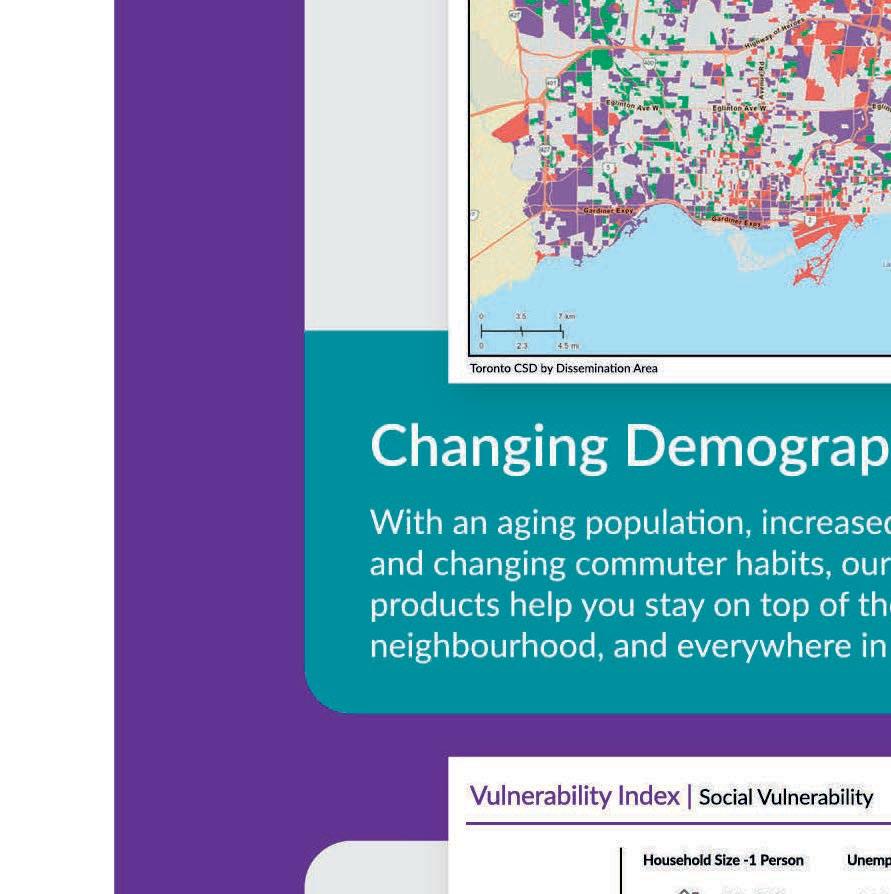
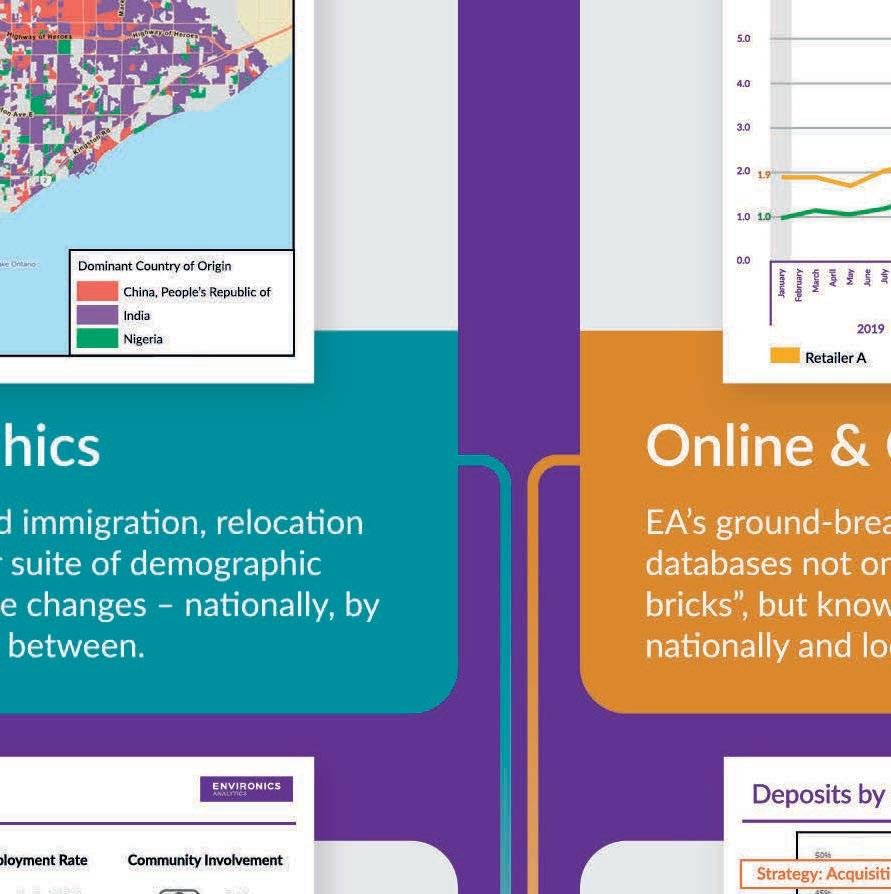



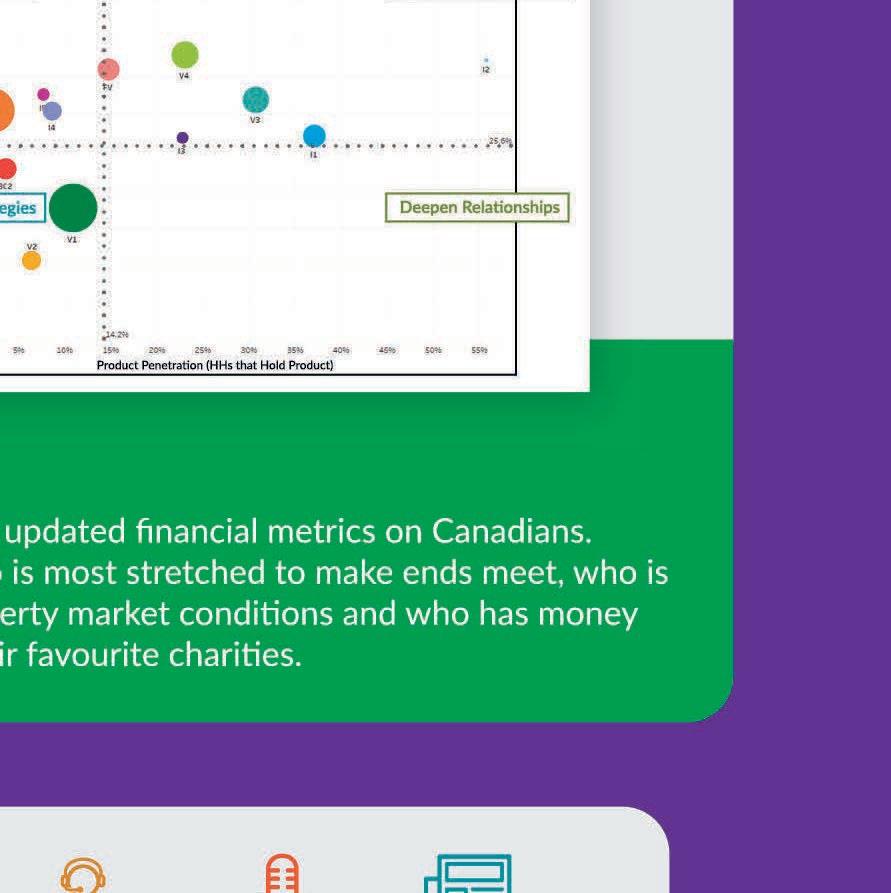
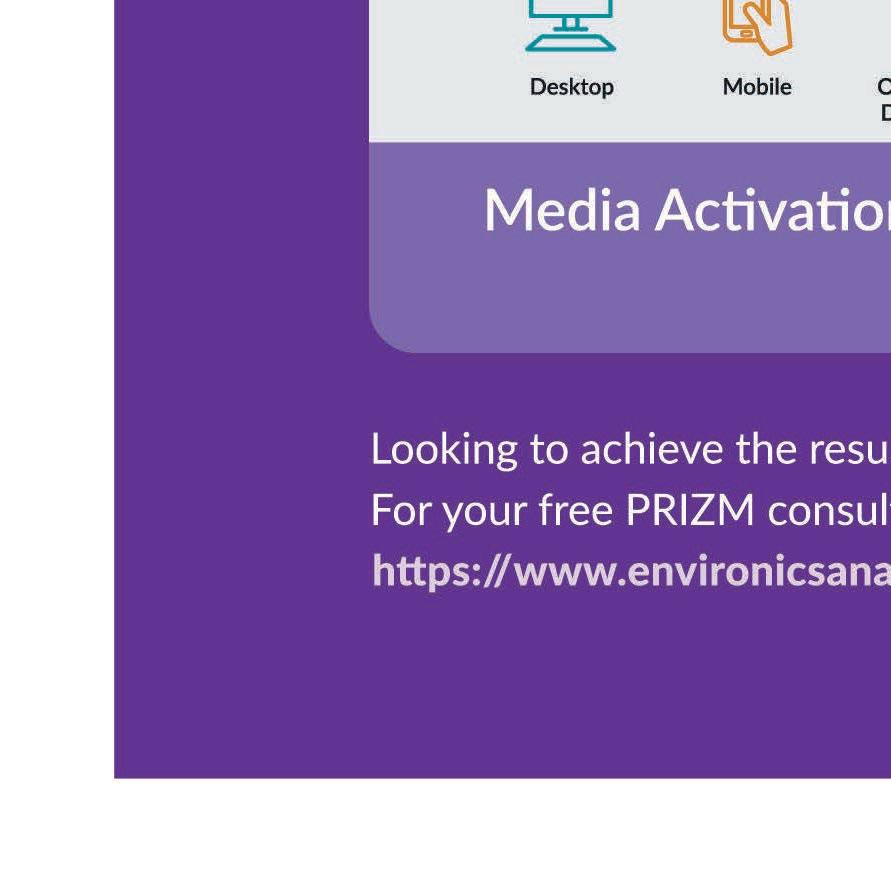

























 BY SARAH CHAMBERLIN
BY SARAH CHAMBERLIN






 BY HEATHER BAKER
BY HEATHER BAKER










 BY JODY SPIEGEL
BY JODY SPIEGEL


 BY LOUISE SPARKS
BY LOUISE SPARKS
























































































